Notion of Honour, Shame, Purity and Pollution in a Transnational Immigrating Bangladesh Community: An Anthropological Study in Toronto, Canada
VerifiedAdded on 2023/06/03
|18
|5028
|263
AI Summary
This research proposal focuses on the transnational immigration of Bangladeshi community in Canada and how their understanding and experiences shape and reshape the notions of honour, shame, purity, and pollution in the host country. The study aims to analyze transitional immigrants of Bangladeshi in Canada with respect to the area of culture, nationalism, diaspora, sexuality, race, gender, and politics. The proposed study is an anthropological study based on transnational immigration of Bangladeshi community in Canada, which creates a broader scope for the discussion on gender, sexuality, race, anthropology, nationalism and several other areas.
Contribute Materials
Your contribution can guide someone’s learning journey. Share your
documents today.
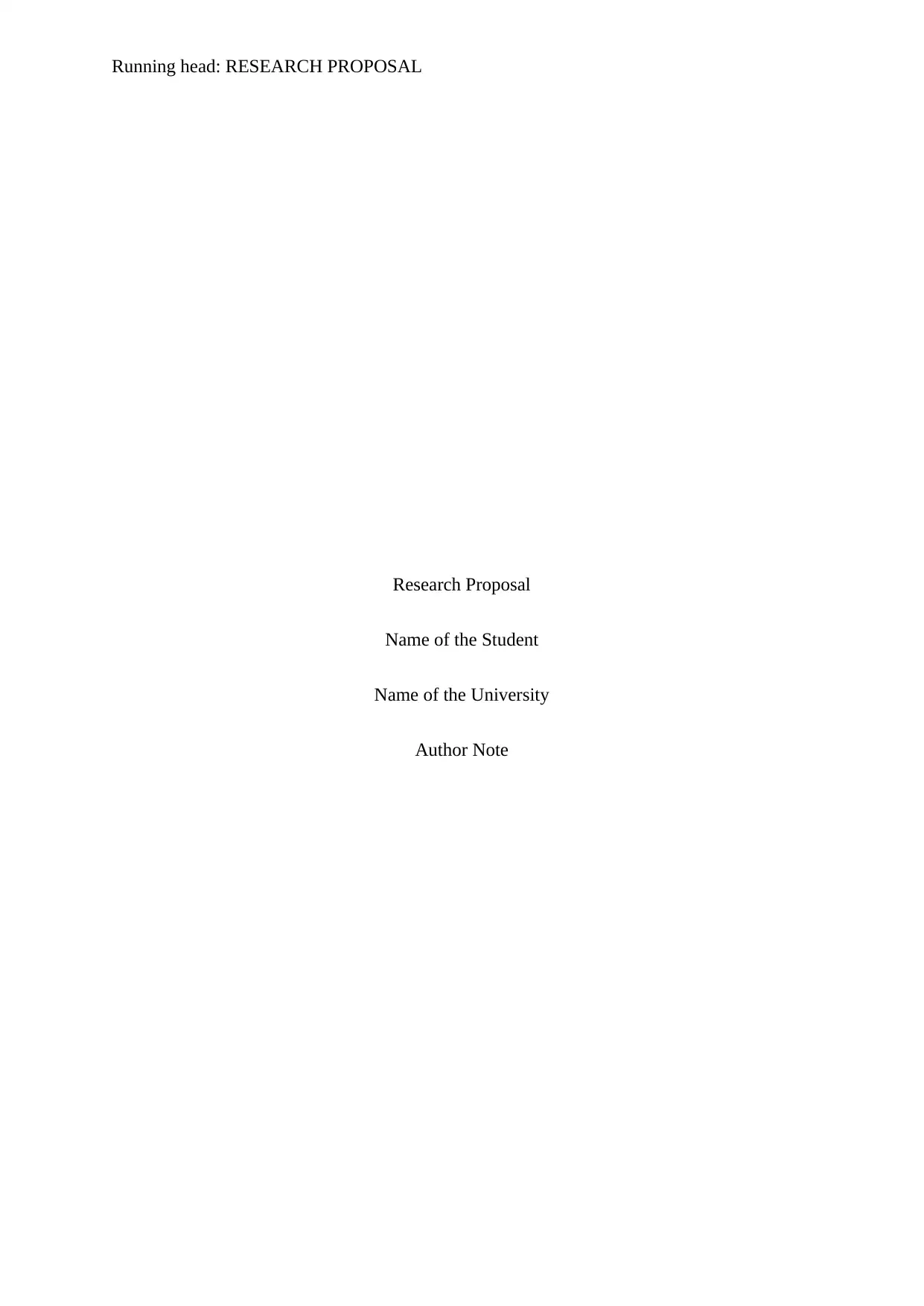
Running head: RESEARCH PROPOSAL
Research Proposal
Name of the Student
Name of the University
Author Note
Research Proposal
Name of the Student
Name of the University
Author Note
Secure Best Marks with AI Grader
Need help grading? Try our AI Grader for instant feedback on your assignments.
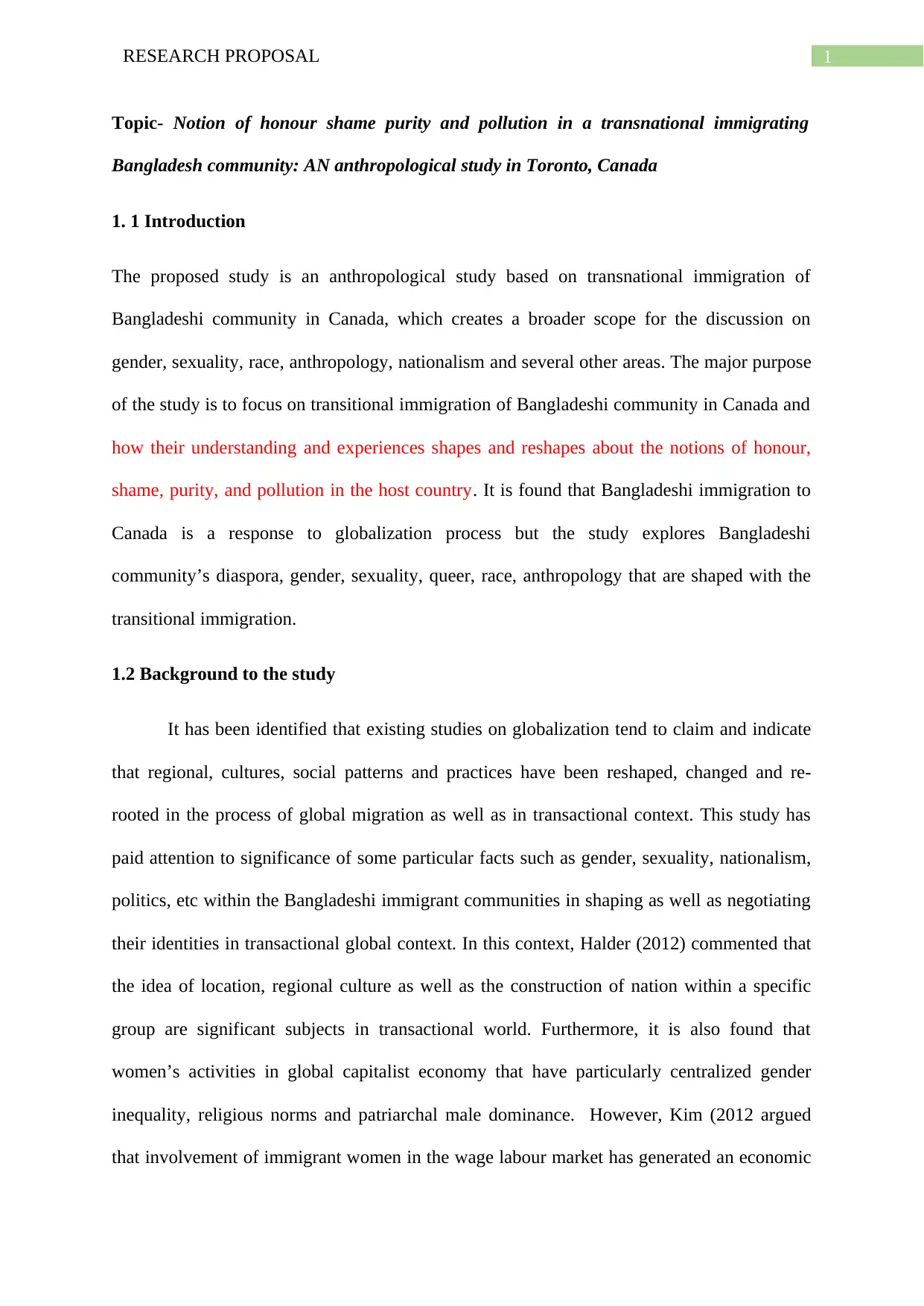
1RESEARCH PROPOSAL
Topic- Notion of honour shame purity and pollution in a transnational immigrating
Bangladesh community: AN anthropological study in Toronto, Canada
1. 1 Introduction
The proposed study is an anthropological study based on transnational immigration of
Bangladeshi community in Canada, which creates a broader scope for the discussion on
gender, sexuality, race, anthropology, nationalism and several other areas. The major purpose
of the study is to focus on transitional immigration of Bangladeshi community in Canada and
how their understanding and experiences shapes and reshapes about the notions of honour,
shame, purity, and pollution in the host country. It is found that Bangladeshi immigration to
Canada is a response to globalization process but the study explores Bangladeshi
community’s diaspora, gender, sexuality, queer, race, anthropology that are shaped with the
transitional immigration.
1.2 Background to the study
It has been identified that existing studies on globalization tend to claim and indicate
that regional, cultures, social patterns and practices have been reshaped, changed and re-
rooted in the process of global migration as well as in transactional context. This study has
paid attention to significance of some particular facts such as gender, sexuality, nationalism,
politics, etc within the Bangladeshi immigrant communities in shaping as well as negotiating
their identities in transactional global context. In this context, Halder (2012) commented that
the idea of location, regional culture as well as the construction of nation within a specific
group are significant subjects in transactional world. Furthermore, it is also found that
women’s activities in global capitalist economy that have particularly centralized gender
inequality, religious norms and patriarchal male dominance. However, Kim (2012 argued
that involvement of immigrant women in the wage labour market has generated an economic
Topic- Notion of honour shame purity and pollution in a transnational immigrating
Bangladesh community: AN anthropological study in Toronto, Canada
1. 1 Introduction
The proposed study is an anthropological study based on transnational immigration of
Bangladeshi community in Canada, which creates a broader scope for the discussion on
gender, sexuality, race, anthropology, nationalism and several other areas. The major purpose
of the study is to focus on transitional immigration of Bangladeshi community in Canada and
how their understanding and experiences shapes and reshapes about the notions of honour,
shame, purity, and pollution in the host country. It is found that Bangladeshi immigration to
Canada is a response to globalization process but the study explores Bangladeshi
community’s diaspora, gender, sexuality, queer, race, anthropology that are shaped with the
transitional immigration.
1.2 Background to the study
It has been identified that existing studies on globalization tend to claim and indicate
that regional, cultures, social patterns and practices have been reshaped, changed and re-
rooted in the process of global migration as well as in transactional context. This study has
paid attention to significance of some particular facts such as gender, sexuality, nationalism,
politics, etc within the Bangladeshi immigrant communities in shaping as well as negotiating
their identities in transactional global context. In this context, Halder (2012) commented that
the idea of location, regional culture as well as the construction of nation within a specific
group are significant subjects in transactional world. Furthermore, it is also found that
women’s activities in global capitalist economy that have particularly centralized gender
inequality, religious norms and patriarchal male dominance. However, Kim (2012 argued
that involvement of immigrant women in the wage labour market has generated an economic
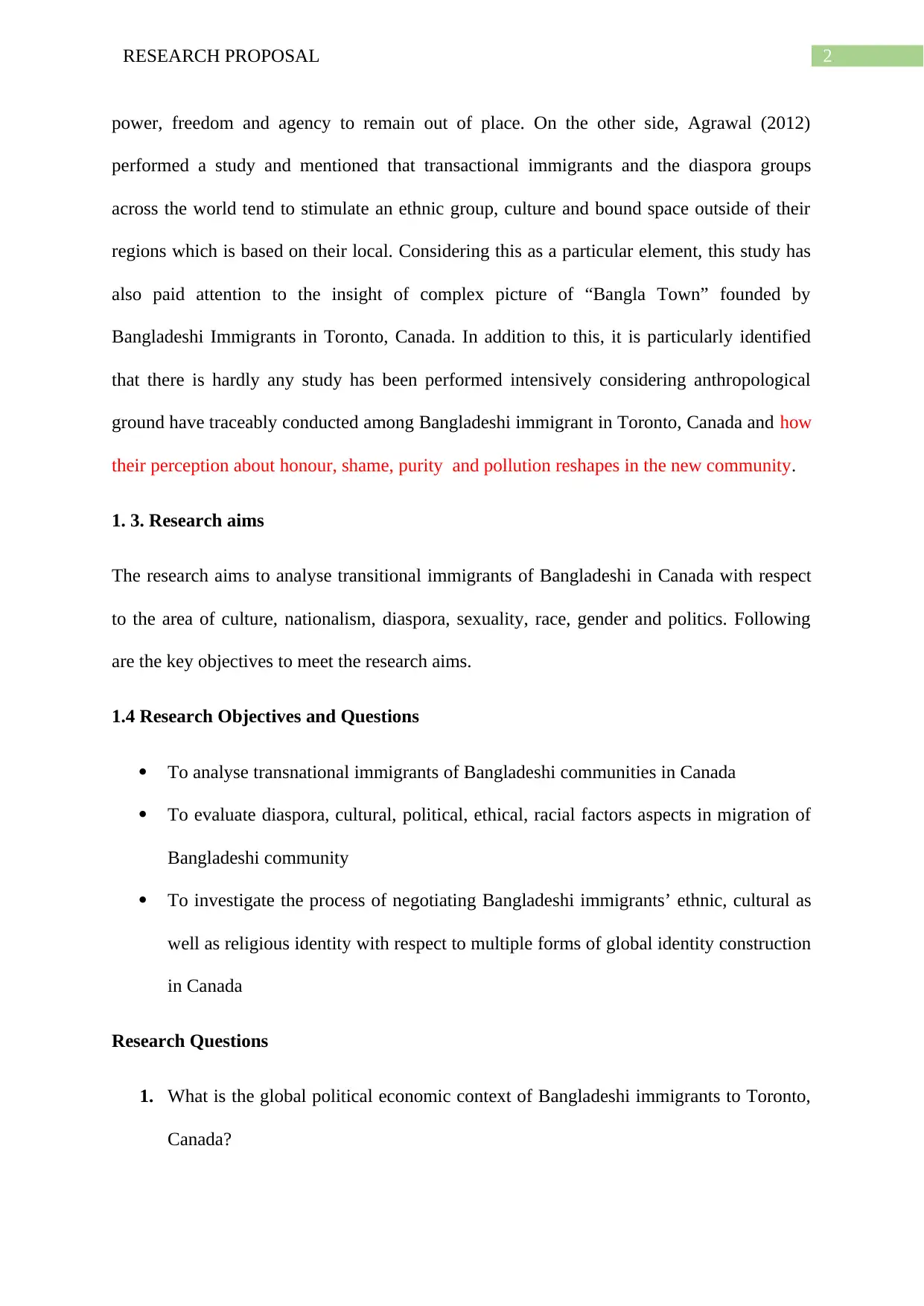
2RESEARCH PROPOSAL
power, freedom and agency to remain out of place. On the other side, Agrawal (2012)
performed a study and mentioned that transactional immigrants and the diaspora groups
across the world tend to stimulate an ethnic group, culture and bound space outside of their
regions which is based on their local. Considering this as a particular element, this study has
also paid attention to the insight of complex picture of “Bangla Town” founded by
Bangladeshi Immigrants in Toronto, Canada. In addition to this, it is particularly identified
that there is hardly any study has been performed intensively considering anthropological
ground have traceably conducted among Bangladeshi immigrant in Toronto, Canada and how
their perception about honour, shame, purity and pollution reshapes in the new community.
1. 3. Research aims
The research aims to analyse transitional immigrants of Bangladeshi in Canada with respect
to the area of culture, nationalism, diaspora, sexuality, race, gender and politics. Following
are the key objectives to meet the research aims.
1.4 Research Objectives and Questions
To analyse transnational immigrants of Bangladeshi communities in Canada
To evaluate diaspora, cultural, political, ethical, racial factors aspects in migration of
Bangladeshi community
To investigate the process of negotiating Bangladeshi immigrants’ ethnic, cultural as
well as religious identity with respect to multiple forms of global identity construction
in Canada
Research Questions
1. What is the global political economic context of Bangladeshi immigrants to Toronto,
Canada?
power, freedom and agency to remain out of place. On the other side, Agrawal (2012)
performed a study and mentioned that transactional immigrants and the diaspora groups
across the world tend to stimulate an ethnic group, culture and bound space outside of their
regions which is based on their local. Considering this as a particular element, this study has
also paid attention to the insight of complex picture of “Bangla Town” founded by
Bangladeshi Immigrants in Toronto, Canada. In addition to this, it is particularly identified
that there is hardly any study has been performed intensively considering anthropological
ground have traceably conducted among Bangladeshi immigrant in Toronto, Canada and how
their perception about honour, shame, purity and pollution reshapes in the new community.
1. 3. Research aims
The research aims to analyse transitional immigrants of Bangladeshi in Canada with respect
to the area of culture, nationalism, diaspora, sexuality, race, gender and politics. Following
are the key objectives to meet the research aims.
1.4 Research Objectives and Questions
To analyse transnational immigrants of Bangladeshi communities in Canada
To evaluate diaspora, cultural, political, ethical, racial factors aspects in migration of
Bangladeshi community
To investigate the process of negotiating Bangladeshi immigrants’ ethnic, cultural as
well as religious identity with respect to multiple forms of global identity construction
in Canada
Research Questions
1. What is the global political economic context of Bangladeshi immigrants to Toronto,
Canada?
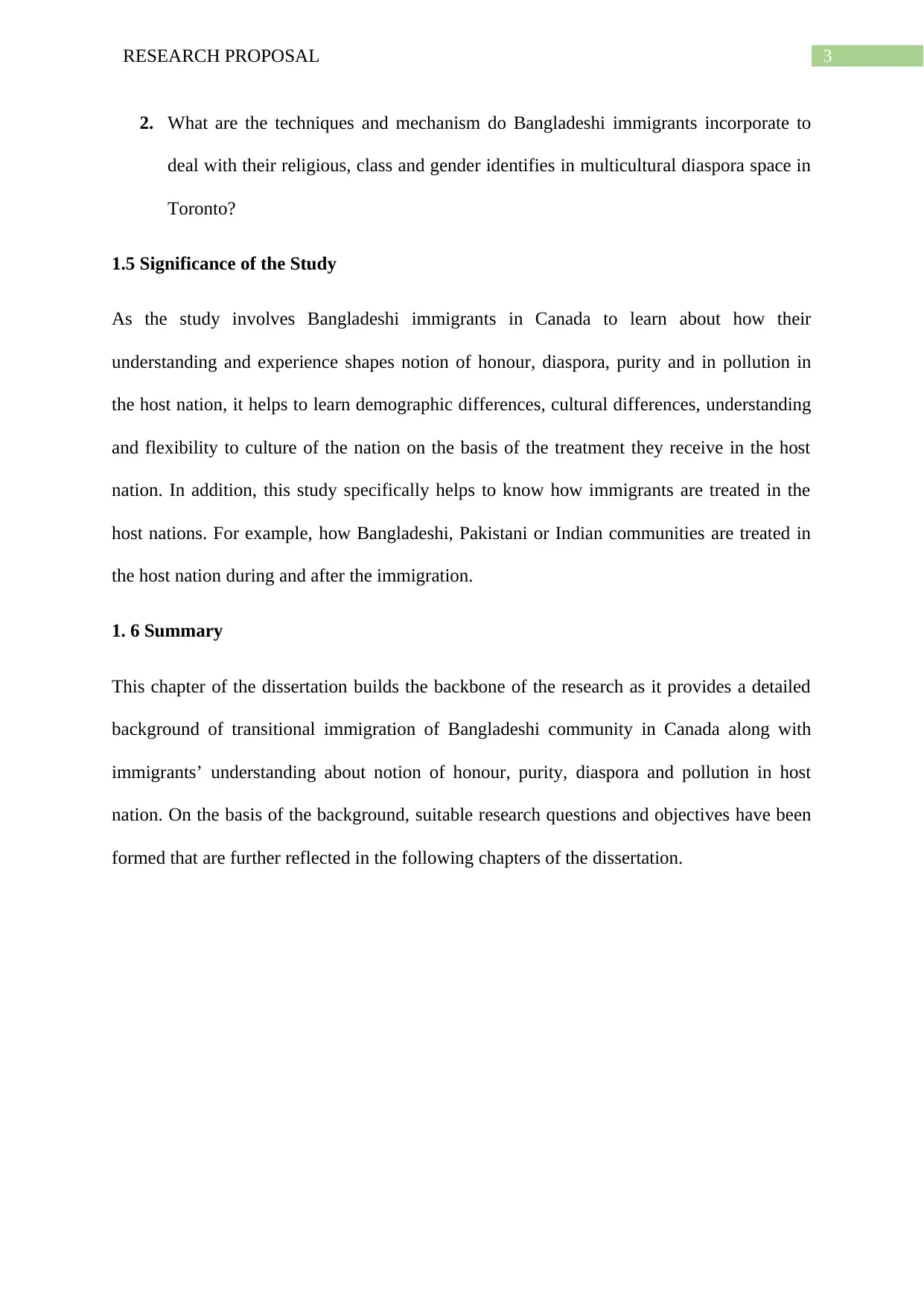
3RESEARCH PROPOSAL
2. What are the techniques and mechanism do Bangladeshi immigrants incorporate to
deal with their religious, class and gender identifies in multicultural diaspora space in
Toronto?
1.5 Significance of the Study
As the study involves Bangladeshi immigrants in Canada to learn about how their
understanding and experience shapes notion of honour, diaspora, purity and in pollution in
the host nation, it helps to learn demographic differences, cultural differences, understanding
and flexibility to culture of the nation on the basis of the treatment they receive in the host
nation. In addition, this study specifically helps to know how immigrants are treated in the
host nations. For example, how Bangladeshi, Pakistani or Indian communities are treated in
the host nation during and after the immigration.
1. 6 Summary
This chapter of the dissertation builds the backbone of the research as it provides a detailed
background of transitional immigration of Bangladeshi community in Canada along with
immigrants’ understanding about notion of honour, purity, diaspora and pollution in host
nation. On the basis of the background, suitable research questions and objectives have been
formed that are further reflected in the following chapters of the dissertation.
2. What are the techniques and mechanism do Bangladeshi immigrants incorporate to
deal with their religious, class and gender identifies in multicultural diaspora space in
Toronto?
1.5 Significance of the Study
As the study involves Bangladeshi immigrants in Canada to learn about how their
understanding and experience shapes notion of honour, diaspora, purity and in pollution in
the host nation, it helps to learn demographic differences, cultural differences, understanding
and flexibility to culture of the nation on the basis of the treatment they receive in the host
nation. In addition, this study specifically helps to know how immigrants are treated in the
host nations. For example, how Bangladeshi, Pakistani or Indian communities are treated in
the host nation during and after the immigration.
1. 6 Summary
This chapter of the dissertation builds the backbone of the research as it provides a detailed
background of transitional immigration of Bangladeshi community in Canada along with
immigrants’ understanding about notion of honour, purity, diaspora and pollution in host
nation. On the basis of the background, suitable research questions and objectives have been
formed that are further reflected in the following chapters of the dissertation.
Secure Best Marks with AI Grader
Need help grading? Try our AI Grader for instant feedback on your assignments.
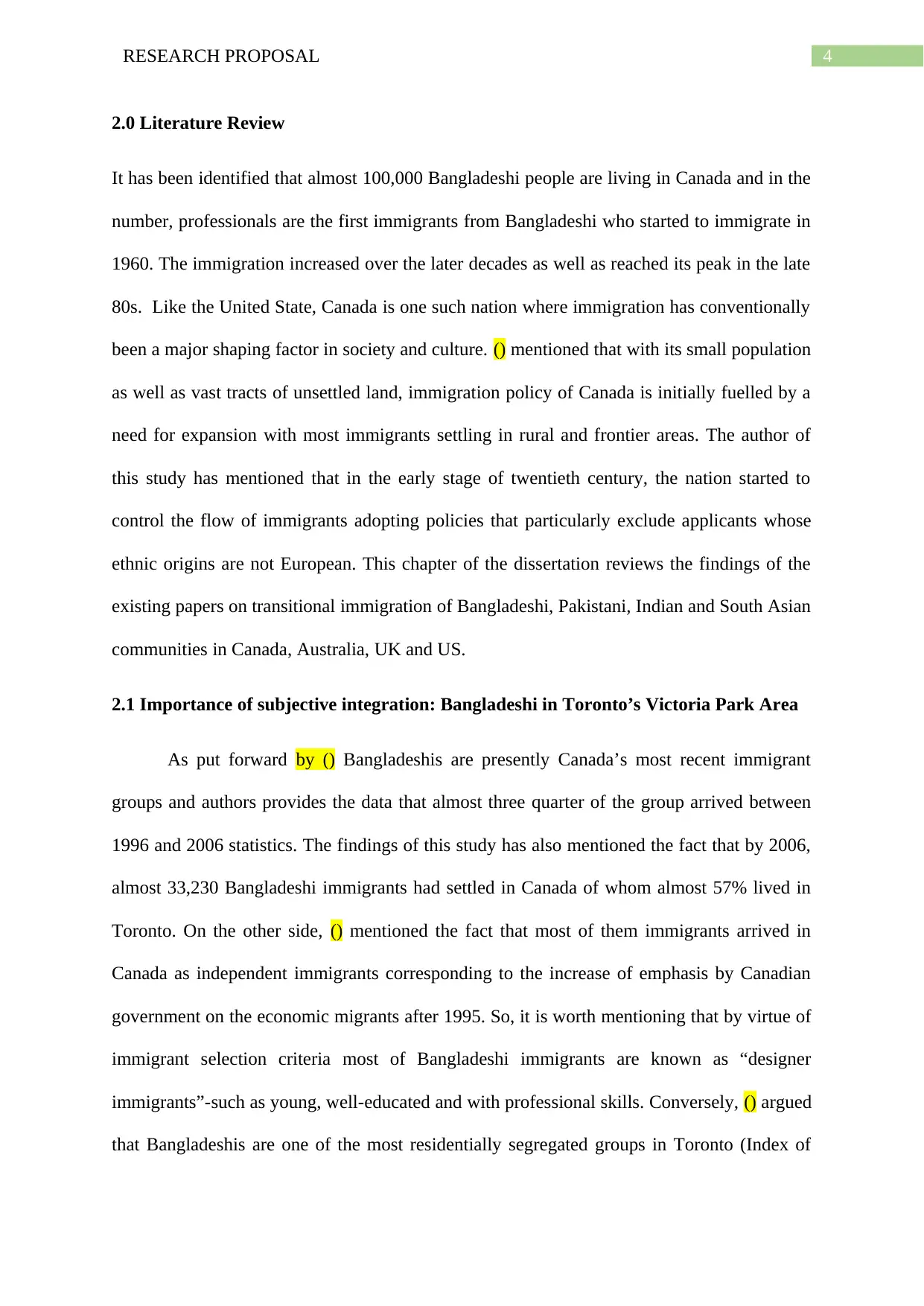
4RESEARCH PROPOSAL
2.0 Literature Review
It has been identified that almost 100,000 Bangladeshi people are living in Canada and in the
number, professionals are the first immigrants from Bangladeshi who started to immigrate in
1960. The immigration increased over the later decades as well as reached its peak in the late
80s. Like the United State, Canada is one such nation where immigration has conventionally
been a major shaping factor in society and culture. () mentioned that with its small population
as well as vast tracts of unsettled land, immigration policy of Canada is initially fuelled by a
need for expansion with most immigrants settling in rural and frontier areas. The author of
this study has mentioned that in the early stage of twentieth century, the nation started to
control the flow of immigrants adopting policies that particularly exclude applicants whose
ethnic origins are not European. This chapter of the dissertation reviews the findings of the
existing papers on transitional immigration of Bangladeshi, Pakistani, Indian and South Asian
communities in Canada, Australia, UK and US.
2.1 Importance of subjective integration: Bangladeshi in Toronto’s Victoria Park Area
As put forward by () Bangladeshis are presently Canada’s most recent immigrant
groups and authors provides the data that almost three quarter of the group arrived between
1996 and 2006 statistics. The findings of this study has also mentioned the fact that by 2006,
almost 33,230 Bangladeshi immigrants had settled in Canada of whom almost 57% lived in
Toronto. On the other side, () mentioned the fact that most of them immigrants arrived in
Canada as independent immigrants corresponding to the increase of emphasis by Canadian
government on the economic migrants after 1995. So, it is worth mentioning that by virtue of
immigrant selection criteria most of Bangladeshi immigrants are known as “designer
immigrants”-such as young, well-educated and with professional skills. Conversely, () argued
that Bangladeshis are one of the most residentially segregated groups in Toronto (Index of
2.0 Literature Review
It has been identified that almost 100,000 Bangladeshi people are living in Canada and in the
number, professionals are the first immigrants from Bangladeshi who started to immigrate in
1960. The immigration increased over the later decades as well as reached its peak in the late
80s. Like the United State, Canada is one such nation where immigration has conventionally
been a major shaping factor in society and culture. () mentioned that with its small population
as well as vast tracts of unsettled land, immigration policy of Canada is initially fuelled by a
need for expansion with most immigrants settling in rural and frontier areas. The author of
this study has mentioned that in the early stage of twentieth century, the nation started to
control the flow of immigrants adopting policies that particularly exclude applicants whose
ethnic origins are not European. This chapter of the dissertation reviews the findings of the
existing papers on transitional immigration of Bangladeshi, Pakistani, Indian and South Asian
communities in Canada, Australia, UK and US.
2.1 Importance of subjective integration: Bangladeshi in Toronto’s Victoria Park Area
As put forward by () Bangladeshis are presently Canada’s most recent immigrant
groups and authors provides the data that almost three quarter of the group arrived between
1996 and 2006 statistics. The findings of this study has also mentioned the fact that by 2006,
almost 33,230 Bangladeshi immigrants had settled in Canada of whom almost 57% lived in
Toronto. On the other side, () mentioned the fact that most of them immigrants arrived in
Canada as independent immigrants corresponding to the increase of emphasis by Canadian
government on the economic migrants after 1995. So, it is worth mentioning that by virtue of
immigrant selection criteria most of Bangladeshi immigrants are known as “designer
immigrants”-such as young, well-educated and with professional skills. Conversely, () argued
that Bangladeshis are one of the most residentially segregated groups in Toronto (Index of
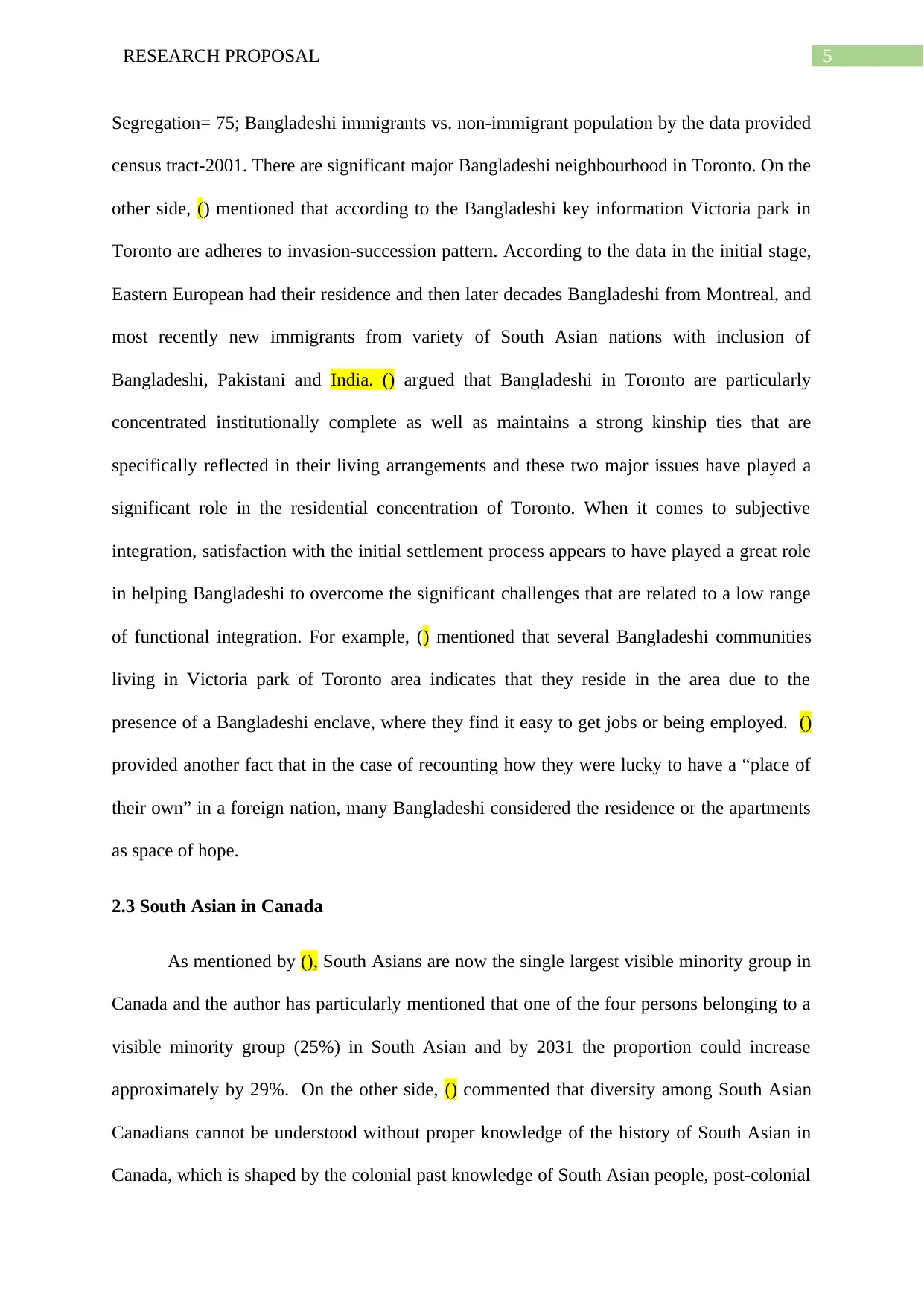
5RESEARCH PROPOSAL
Segregation= 75; Bangladeshi immigrants vs. non-immigrant population by the data provided
census tract-2001. There are significant major Bangladeshi neighbourhood in Toronto. On the
other side, () mentioned that according to the Bangladeshi key information Victoria park in
Toronto are adheres to invasion-succession pattern. According to the data in the initial stage,
Eastern European had their residence and then later decades Bangladeshi from Montreal, and
most recently new immigrants from variety of South Asian nations with inclusion of
Bangladeshi, Pakistani and India. () argued that Bangladeshi in Toronto are particularly
concentrated institutionally complete as well as maintains a strong kinship ties that are
specifically reflected in their living arrangements and these two major issues have played a
significant role in the residential concentration of Toronto. When it comes to subjective
integration, satisfaction with the initial settlement process appears to have played a great role
in helping Bangladeshi to overcome the significant challenges that are related to a low range
of functional integration. For example, () mentioned that several Bangladeshi communities
living in Victoria park of Toronto area indicates that they reside in the area due to the
presence of a Bangladeshi enclave, where they find it easy to get jobs or being employed. ()
provided another fact that in the case of recounting how they were lucky to have a “place of
their own” in a foreign nation, many Bangladeshi considered the residence or the apartments
as space of hope.
2.3 South Asian in Canada
As mentioned by (), South Asians are now the single largest visible minority group in
Canada and the author has particularly mentioned that one of the four persons belonging to a
visible minority group (25%) in South Asian and by 2031 the proportion could increase
approximately by 29%. On the other side, () commented that diversity among South Asian
Canadians cannot be understood without proper knowledge of the history of South Asian in
Canada, which is shaped by the colonial past knowledge of South Asian people, post-colonial
Segregation= 75; Bangladeshi immigrants vs. non-immigrant population by the data provided
census tract-2001. There are significant major Bangladeshi neighbourhood in Toronto. On the
other side, () mentioned that according to the Bangladeshi key information Victoria park in
Toronto are adheres to invasion-succession pattern. According to the data in the initial stage,
Eastern European had their residence and then later decades Bangladeshi from Montreal, and
most recently new immigrants from variety of South Asian nations with inclusion of
Bangladeshi, Pakistani and India. () argued that Bangladeshi in Toronto are particularly
concentrated institutionally complete as well as maintains a strong kinship ties that are
specifically reflected in their living arrangements and these two major issues have played a
significant role in the residential concentration of Toronto. When it comes to subjective
integration, satisfaction with the initial settlement process appears to have played a great role
in helping Bangladeshi to overcome the significant challenges that are related to a low range
of functional integration. For example, () mentioned that several Bangladeshi communities
living in Victoria park of Toronto area indicates that they reside in the area due to the
presence of a Bangladeshi enclave, where they find it easy to get jobs or being employed. ()
provided another fact that in the case of recounting how they were lucky to have a “place of
their own” in a foreign nation, many Bangladeshi considered the residence or the apartments
as space of hope.
2.3 South Asian in Canada
As mentioned by (), South Asians are now the single largest visible minority group in
Canada and the author has particularly mentioned that one of the four persons belonging to a
visible minority group (25%) in South Asian and by 2031 the proportion could increase
approximately by 29%. On the other side, () commented that diversity among South Asian
Canadians cannot be understood without proper knowledge of the history of South Asian in
Canada, which is shaped by the colonial past knowledge of South Asian people, post-colonial
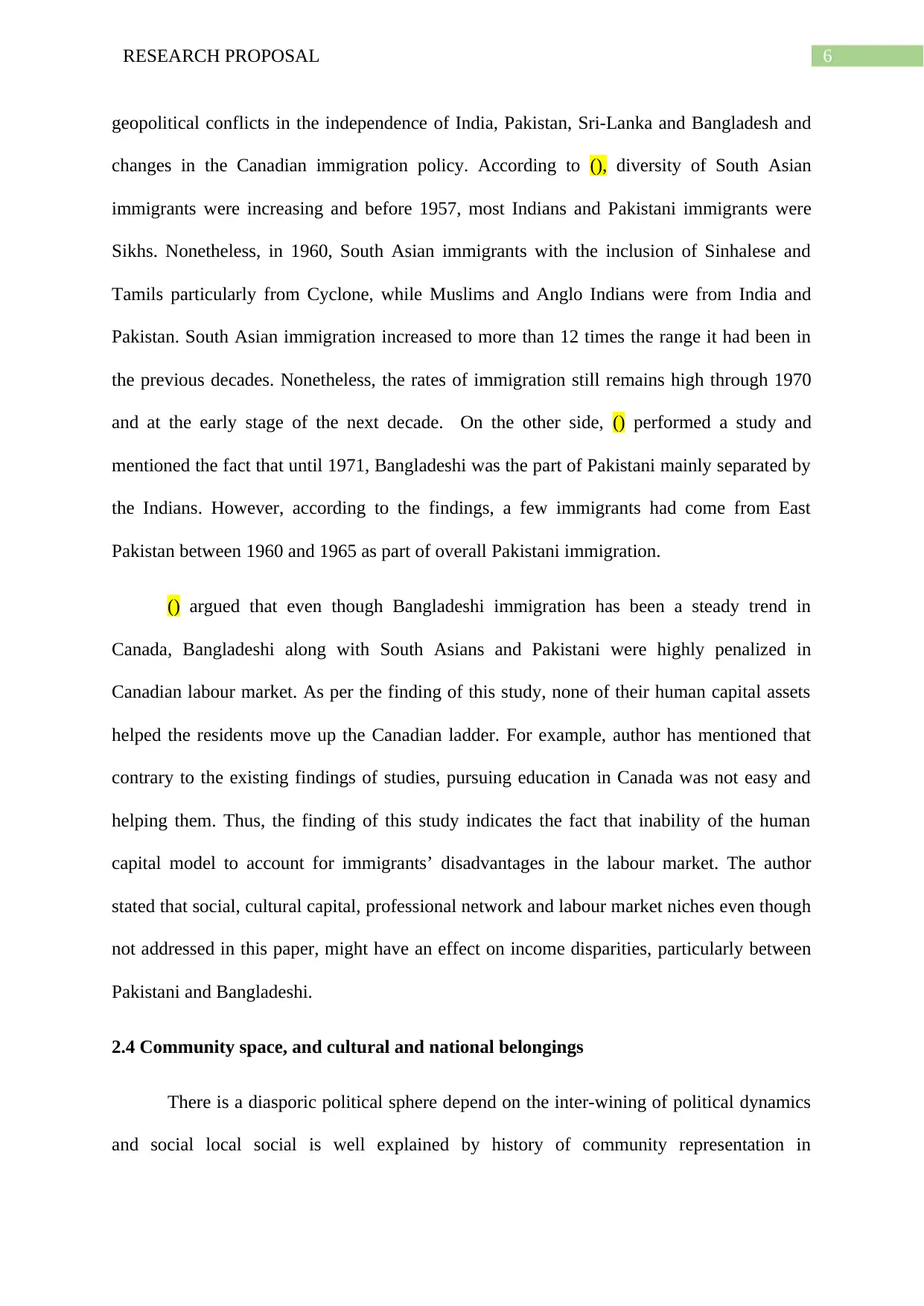
6RESEARCH PROPOSAL
geopolitical conflicts in the independence of India, Pakistan, Sri-Lanka and Bangladesh and
changes in the Canadian immigration policy. According to (), diversity of South Asian
immigrants were increasing and before 1957, most Indians and Pakistani immigrants were
Sikhs. Nonetheless, in 1960, South Asian immigrants with the inclusion of Sinhalese and
Tamils particularly from Cyclone, while Muslims and Anglo Indians were from India and
Pakistan. South Asian immigration increased to more than 12 times the range it had been in
the previous decades. Nonetheless, the rates of immigration still remains high through 1970
and at the early stage of the next decade. On the other side, () performed a study and
mentioned the fact that until 1971, Bangladeshi was the part of Pakistani mainly separated by
the Indians. However, according to the findings, a few immigrants had come from East
Pakistan between 1960 and 1965 as part of overall Pakistani immigration.
() argued that even though Bangladeshi immigration has been a steady trend in
Canada, Bangladeshi along with South Asians and Pakistani were highly penalized in
Canadian labour market. As per the finding of this study, none of their human capital assets
helped the residents move up the Canadian ladder. For example, author has mentioned that
contrary to the existing findings of studies, pursuing education in Canada was not easy and
helping them. Thus, the finding of this study indicates the fact that inability of the human
capital model to account for immigrants’ disadvantages in the labour market. The author
stated that social, cultural capital, professional network and labour market niches even though
not addressed in this paper, might have an effect on income disparities, particularly between
Pakistani and Bangladeshi.
2.4 Community space, and cultural and national belongings
There is a diasporic political sphere depend on the inter-wining of political dynamics
and social local social is well explained by history of community representation in
geopolitical conflicts in the independence of India, Pakistan, Sri-Lanka and Bangladesh and
changes in the Canadian immigration policy. According to (), diversity of South Asian
immigrants were increasing and before 1957, most Indians and Pakistani immigrants were
Sikhs. Nonetheless, in 1960, South Asian immigrants with the inclusion of Sinhalese and
Tamils particularly from Cyclone, while Muslims and Anglo Indians were from India and
Pakistan. South Asian immigration increased to more than 12 times the range it had been in
the previous decades. Nonetheless, the rates of immigration still remains high through 1970
and at the early stage of the next decade. On the other side, () performed a study and
mentioned the fact that until 1971, Bangladeshi was the part of Pakistani mainly separated by
the Indians. However, according to the findings, a few immigrants had come from East
Pakistan between 1960 and 1965 as part of overall Pakistani immigration.
() argued that even though Bangladeshi immigration has been a steady trend in
Canada, Bangladeshi along with South Asians and Pakistani were highly penalized in
Canadian labour market. As per the finding of this study, none of their human capital assets
helped the residents move up the Canadian ladder. For example, author has mentioned that
contrary to the existing findings of studies, pursuing education in Canada was not easy and
helping them. Thus, the finding of this study indicates the fact that inability of the human
capital model to account for immigrants’ disadvantages in the labour market. The author
stated that social, cultural capital, professional network and labour market niches even though
not addressed in this paper, might have an effect on income disparities, particularly between
Pakistani and Bangladeshi.
2.4 Community space, and cultural and national belongings
There is a diasporic political sphere depend on the inter-wining of political dynamics
and social local social is well explained by history of community representation in
Paraphrase This Document
Need a fresh take? Get an instant paraphrase of this document with our AI Paraphraser
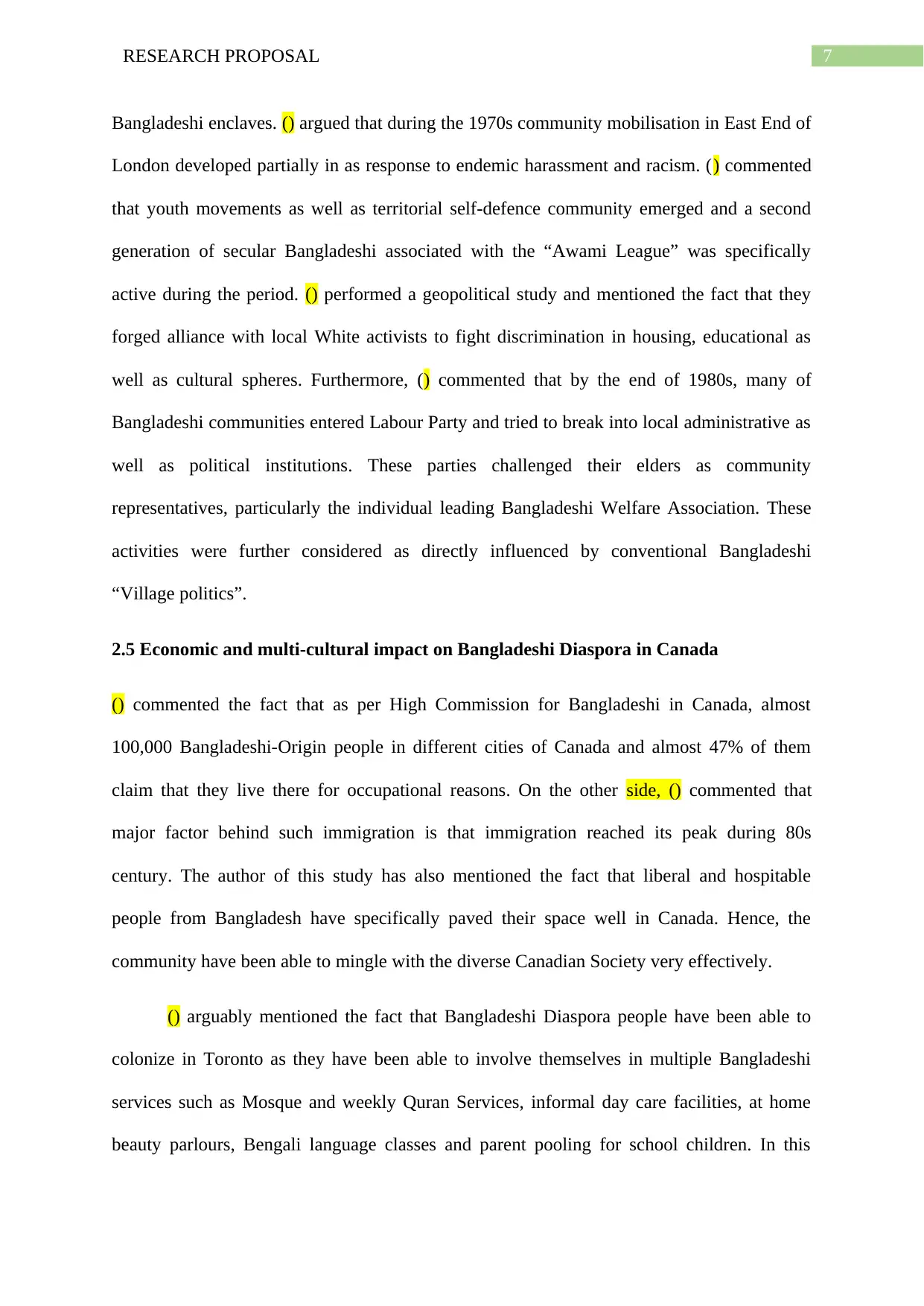
7RESEARCH PROPOSAL
Bangladeshi enclaves. () argued that during the 1970s community mobilisation in East End of
London developed partially in as response to endemic harassment and racism. () commented
that youth movements as well as territorial self-defence community emerged and a second
generation of secular Bangladeshi associated with the “Awami League” was specifically
active during the period. () performed a geopolitical study and mentioned the fact that they
forged alliance with local White activists to fight discrimination in housing, educational as
well as cultural spheres. Furthermore, () commented that by the end of 1980s, many of
Bangladeshi communities entered Labour Party and tried to break into local administrative as
well as political institutions. These parties challenged their elders as community
representatives, particularly the individual leading Bangladeshi Welfare Association. These
activities were further considered as directly influenced by conventional Bangladeshi
“Village politics”.
2.5 Economic and multi-cultural impact on Bangladeshi Diaspora in Canada
() commented the fact that as per High Commission for Bangladeshi in Canada, almost
100,000 Bangladeshi-Origin people in different cities of Canada and almost 47% of them
claim that they live there for occupational reasons. On the other side, () commented that
major factor behind such immigration is that immigration reached its peak during 80s
century. The author of this study has also mentioned the fact that liberal and hospitable
people from Bangladesh have specifically paved their space well in Canada. Hence, the
community have been able to mingle with the diverse Canadian Society very effectively.
() arguably mentioned the fact that Bangladeshi Diaspora people have been able to
colonize in Toronto as they have been able to involve themselves in multiple Bangladeshi
services such as Mosque and weekly Quran Services, informal day care facilities, at home
beauty parlours, Bengali language classes and parent pooling for school children. In this
Bangladeshi enclaves. () argued that during the 1970s community mobilisation in East End of
London developed partially in as response to endemic harassment and racism. () commented
that youth movements as well as territorial self-defence community emerged and a second
generation of secular Bangladeshi associated with the “Awami League” was specifically
active during the period. () performed a geopolitical study and mentioned the fact that they
forged alliance with local White activists to fight discrimination in housing, educational as
well as cultural spheres. Furthermore, () commented that by the end of 1980s, many of
Bangladeshi communities entered Labour Party and tried to break into local administrative as
well as political institutions. These parties challenged their elders as community
representatives, particularly the individual leading Bangladeshi Welfare Association. These
activities were further considered as directly influenced by conventional Bangladeshi
“Village politics”.
2.5 Economic and multi-cultural impact on Bangladeshi Diaspora in Canada
() commented the fact that as per High Commission for Bangladeshi in Canada, almost
100,000 Bangladeshi-Origin people in different cities of Canada and almost 47% of them
claim that they live there for occupational reasons. On the other side, () commented that
major factor behind such immigration is that immigration reached its peak during 80s
century. The author of this study has also mentioned the fact that liberal and hospitable
people from Bangladesh have specifically paved their space well in Canada. Hence, the
community have been able to mingle with the diverse Canadian Society very effectively.
() arguably mentioned the fact that Bangladeshi Diaspora people have been able to
colonize in Toronto as they have been able to involve themselves in multiple Bangladeshi
services such as Mosque and weekly Quran Services, informal day care facilities, at home
beauty parlours, Bengali language classes and parent pooling for school children. In this
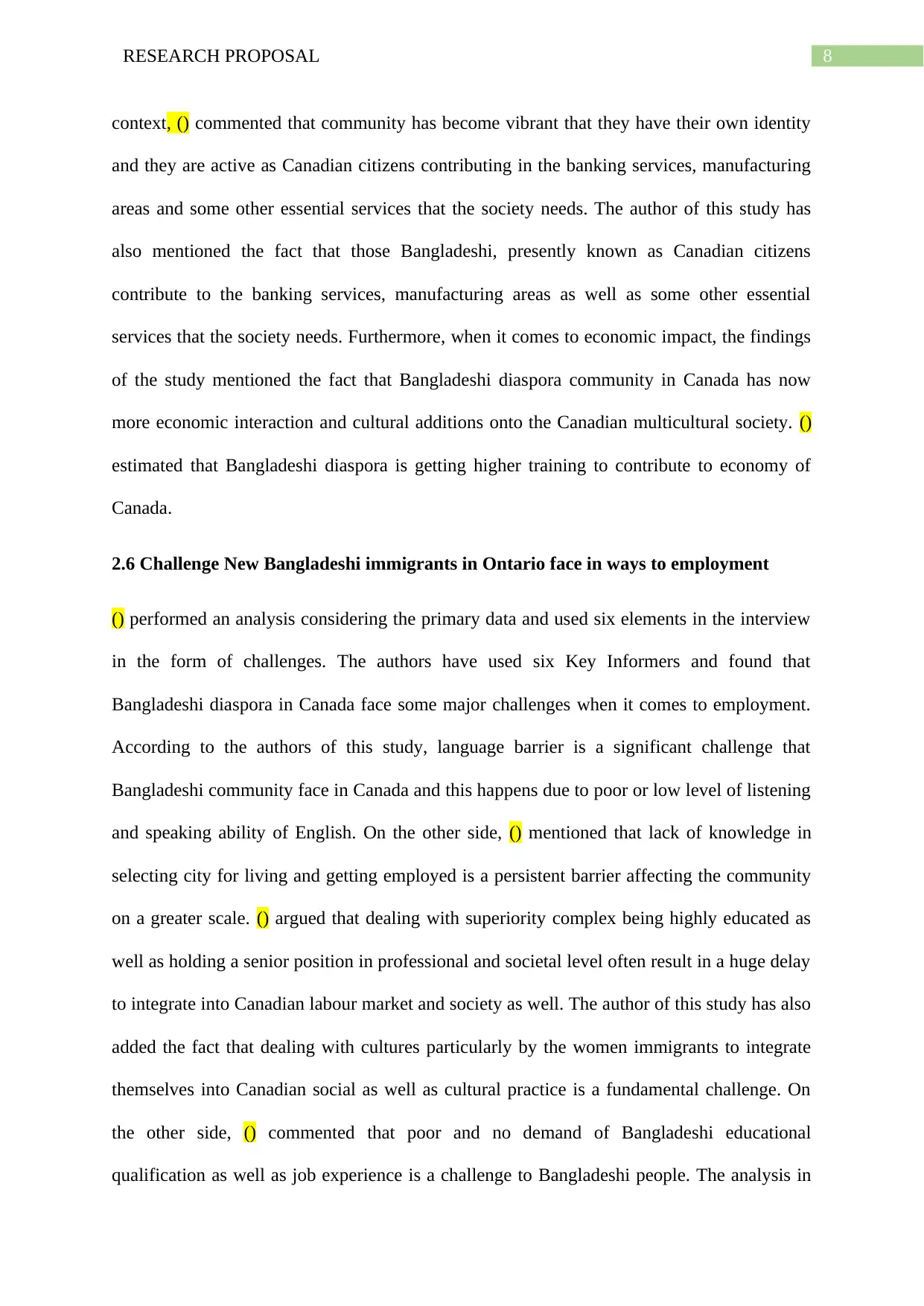
8RESEARCH PROPOSAL
context, () commented that community has become vibrant that they have their own identity
and they are active as Canadian citizens contributing in the banking services, manufacturing
areas and some other essential services that the society needs. The author of this study has
also mentioned the fact that those Bangladeshi, presently known as Canadian citizens
contribute to the banking services, manufacturing areas as well as some other essential
services that the society needs. Furthermore, when it comes to economic impact, the findings
of the study mentioned the fact that Bangladeshi diaspora community in Canada has now
more economic interaction and cultural additions onto the Canadian multicultural society. ()
estimated that Bangladeshi diaspora is getting higher training to contribute to economy of
Canada.
2.6 Challenge New Bangladeshi immigrants in Ontario face in ways to employment
() performed an analysis considering the primary data and used six elements in the interview
in the form of challenges. The authors have used six Key Informers and found that
Bangladeshi diaspora in Canada face some major challenges when it comes to employment.
According to the authors of this study, language barrier is a significant challenge that
Bangladeshi community face in Canada and this happens due to poor or low level of listening
and speaking ability of English. On the other side, () mentioned that lack of knowledge in
selecting city for living and getting employed is a persistent barrier affecting the community
on a greater scale. () argued that dealing with superiority complex being highly educated as
well as holding a senior position in professional and societal level often result in a huge delay
to integrate into Canadian labour market and society as well. The author of this study has also
added the fact that dealing with cultures particularly by the women immigrants to integrate
themselves into Canadian social as well as cultural practice is a fundamental challenge. On
the other side, () commented that poor and no demand of Bangladeshi educational
qualification as well as job experience is a challenge to Bangladeshi people. The analysis in
context, () commented that community has become vibrant that they have their own identity
and they are active as Canadian citizens contributing in the banking services, manufacturing
areas and some other essential services that the society needs. The author of this study has
also mentioned the fact that those Bangladeshi, presently known as Canadian citizens
contribute to the banking services, manufacturing areas as well as some other essential
services that the society needs. Furthermore, when it comes to economic impact, the findings
of the study mentioned the fact that Bangladeshi diaspora community in Canada has now
more economic interaction and cultural additions onto the Canadian multicultural society. ()
estimated that Bangladeshi diaspora is getting higher training to contribute to economy of
Canada.
2.6 Challenge New Bangladeshi immigrants in Ontario face in ways to employment
() performed an analysis considering the primary data and used six elements in the interview
in the form of challenges. The authors have used six Key Informers and found that
Bangladeshi diaspora in Canada face some major challenges when it comes to employment.
According to the authors of this study, language barrier is a significant challenge that
Bangladeshi community face in Canada and this happens due to poor or low level of listening
and speaking ability of English. On the other side, () mentioned that lack of knowledge in
selecting city for living and getting employed is a persistent barrier affecting the community
on a greater scale. () argued that dealing with superiority complex being highly educated as
well as holding a senior position in professional and societal level often result in a huge delay
to integrate into Canadian labour market and society as well. The author of this study has also
added the fact that dealing with cultures particularly by the women immigrants to integrate
themselves into Canadian social as well as cultural practice is a fundamental challenge. On
the other side, () commented that poor and no demand of Bangladeshi educational
qualification as well as job experience is a challenge to Bangladeshi people. The analysis in
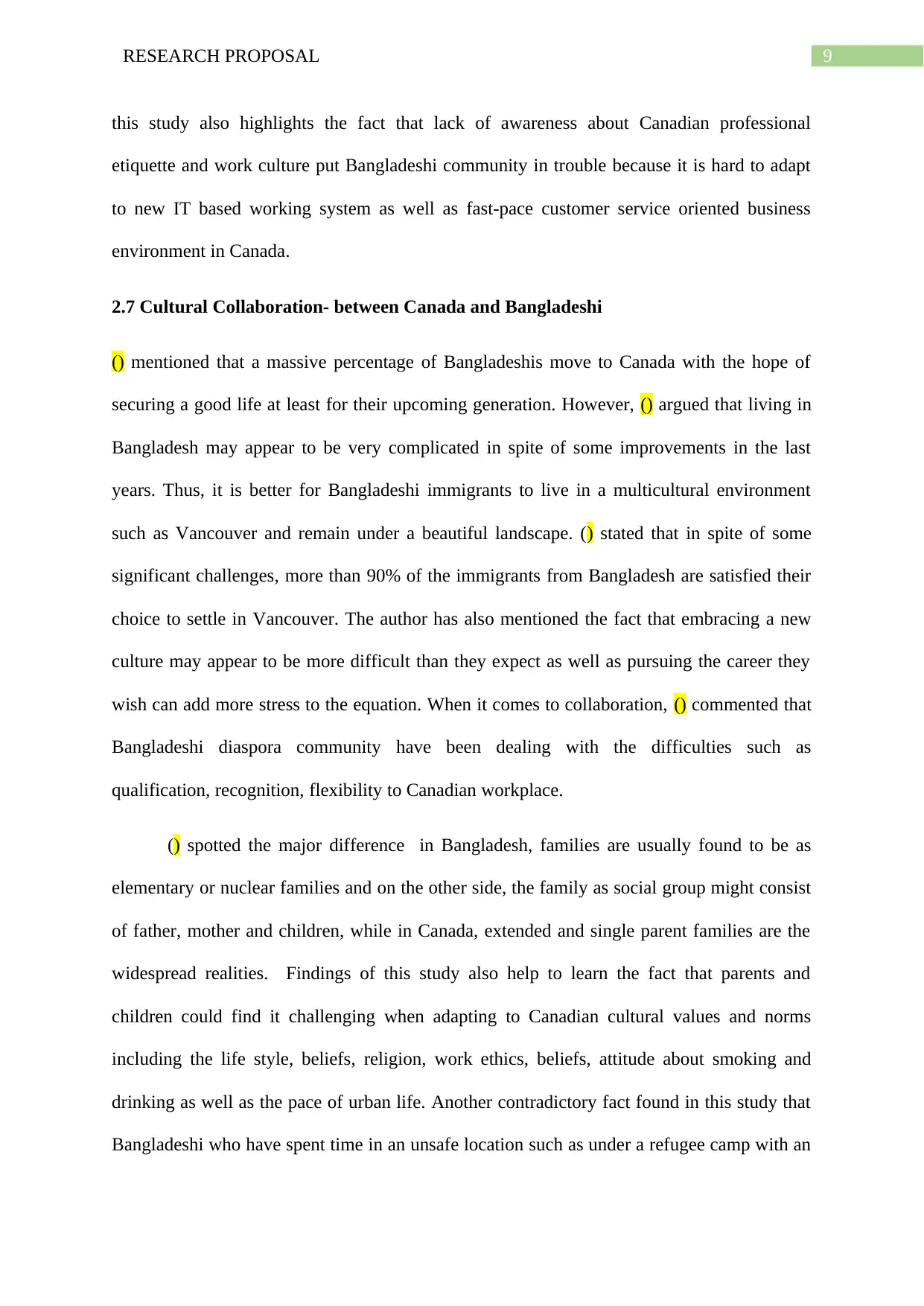
9RESEARCH PROPOSAL
this study also highlights the fact that lack of awareness about Canadian professional
etiquette and work culture put Bangladeshi community in trouble because it is hard to adapt
to new IT based working system as well as fast-pace customer service oriented business
environment in Canada.
2.7 Cultural Collaboration- between Canada and Bangladeshi
() mentioned that a massive percentage of Bangladeshis move to Canada with the hope of
securing a good life at least for their upcoming generation. However, () argued that living in
Bangladesh may appear to be very complicated in spite of some improvements in the last
years. Thus, it is better for Bangladeshi immigrants to live in a multicultural environment
such as Vancouver and remain under a beautiful landscape. () stated that in spite of some
significant challenges, more than 90% of the immigrants from Bangladesh are satisfied their
choice to settle in Vancouver. The author has also mentioned the fact that embracing a new
culture may appear to be more difficult than they expect as well as pursuing the career they
wish can add more stress to the equation. When it comes to collaboration, () commented that
Bangladeshi diaspora community have been dealing with the difficulties such as
qualification, recognition, flexibility to Canadian workplace.
() spotted the major difference in Bangladesh, families are usually found to be as
elementary or nuclear families and on the other side, the family as social group might consist
of father, mother and children, while in Canada, extended and single parent families are the
widespread realities. Findings of this study also help to learn the fact that parents and
children could find it challenging when adapting to Canadian cultural values and norms
including the life style, beliefs, religion, work ethics, beliefs, attitude about smoking and
drinking as well as the pace of urban life. Another contradictory fact found in this study that
Bangladeshi who have spent time in an unsafe location such as under a refugee camp with an
this study also highlights the fact that lack of awareness about Canadian professional
etiquette and work culture put Bangladeshi community in trouble because it is hard to adapt
to new IT based working system as well as fast-pace customer service oriented business
environment in Canada.
2.7 Cultural Collaboration- between Canada and Bangladeshi
() mentioned that a massive percentage of Bangladeshis move to Canada with the hope of
securing a good life at least for their upcoming generation. However, () argued that living in
Bangladesh may appear to be very complicated in spite of some improvements in the last
years. Thus, it is better for Bangladeshi immigrants to live in a multicultural environment
such as Vancouver and remain under a beautiful landscape. () stated that in spite of some
significant challenges, more than 90% of the immigrants from Bangladesh are satisfied their
choice to settle in Vancouver. The author has also mentioned the fact that embracing a new
culture may appear to be more difficult than they expect as well as pursuing the career they
wish can add more stress to the equation. When it comes to collaboration, () commented that
Bangladeshi diaspora community have been dealing with the difficulties such as
qualification, recognition, flexibility to Canadian workplace.
() spotted the major difference in Bangladesh, families are usually found to be as
elementary or nuclear families and on the other side, the family as social group might consist
of father, mother and children, while in Canada, extended and single parent families are the
widespread realities. Findings of this study also help to learn the fact that parents and
children could find it challenging when adapting to Canadian cultural values and norms
including the life style, beliefs, religion, work ethics, beliefs, attitude about smoking and
drinking as well as the pace of urban life. Another contradictory fact found in this study that
Bangladeshi who have spent time in an unsafe location such as under a refugee camp with an
Secure Best Marks with AI Grader
Need help grading? Try our AI Grader for instant feedback on your assignments.
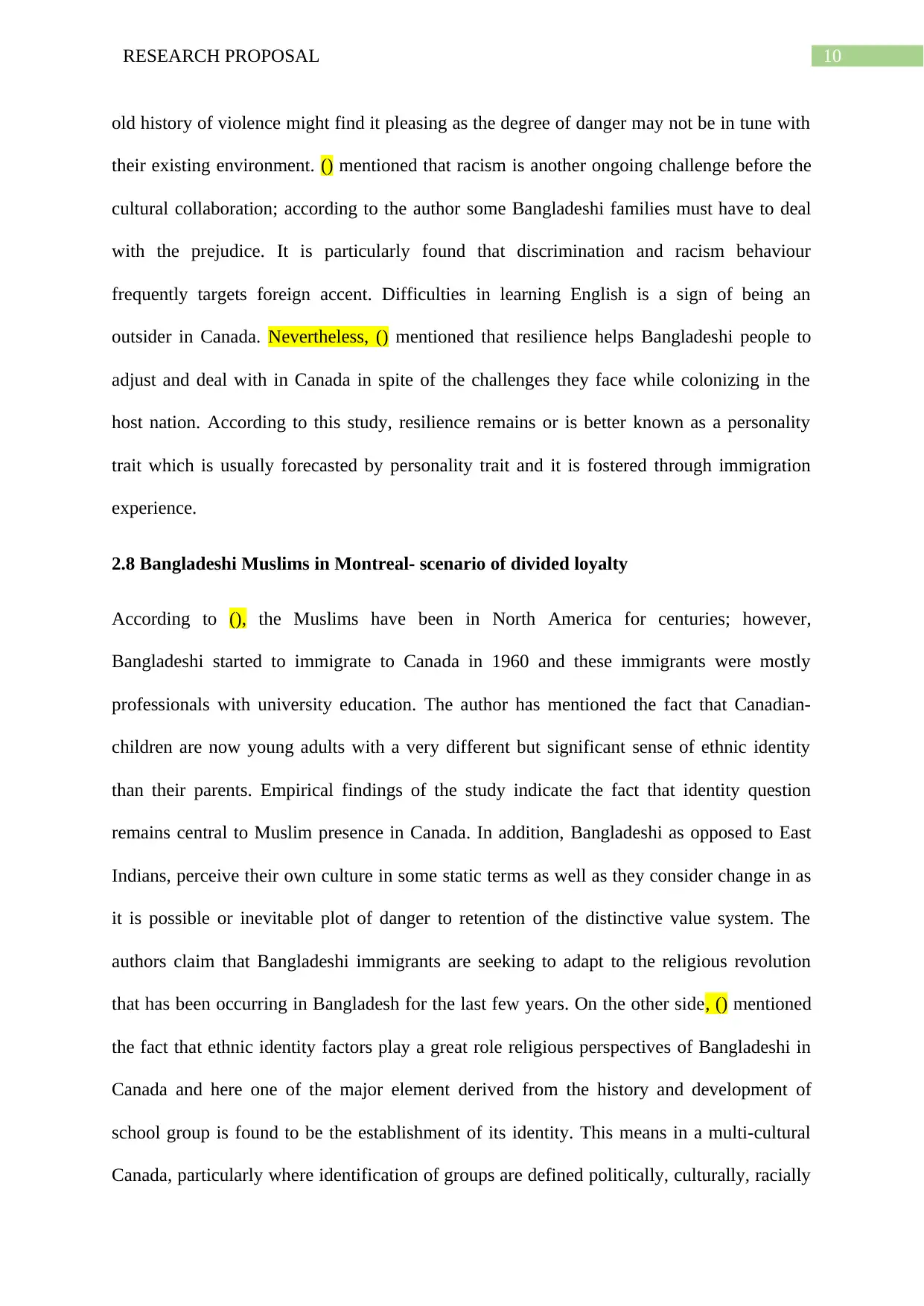
10RESEARCH PROPOSAL
old history of violence might find it pleasing as the degree of danger may not be in tune with
their existing environment. () mentioned that racism is another ongoing challenge before the
cultural collaboration; according to the author some Bangladeshi families must have to deal
with the prejudice. It is particularly found that discrimination and racism behaviour
frequently targets foreign accent. Difficulties in learning English is a sign of being an
outsider in Canada. Nevertheless, () mentioned that resilience helps Bangladeshi people to
adjust and deal with in Canada in spite of the challenges they face while colonizing in the
host nation. According to this study, resilience remains or is better known as a personality
trait which is usually forecasted by personality trait and it is fostered through immigration
experience.
2.8 Bangladeshi Muslims in Montreal- scenario of divided loyalty
According to (), the Muslims have been in North America for centuries; however,
Bangladeshi started to immigrate to Canada in 1960 and these immigrants were mostly
professionals with university education. The author has mentioned the fact that Canadian-
children are now young adults with a very different but significant sense of ethnic identity
than their parents. Empirical findings of the study indicate the fact that identity question
remains central to Muslim presence in Canada. In addition, Bangladeshi as opposed to East
Indians, perceive their own culture in some static terms as well as they consider change in as
it is possible or inevitable plot of danger to retention of the distinctive value system. The
authors claim that Bangladeshi immigrants are seeking to adapt to the religious revolution
that has been occurring in Bangladesh for the last few years. On the other side, () mentioned
the fact that ethnic identity factors play a great role religious perspectives of Bangladeshi in
Canada and here one of the major element derived from the history and development of
school group is found to be the establishment of its identity. This means in a multi-cultural
Canada, particularly where identification of groups are defined politically, culturally, racially
old history of violence might find it pleasing as the degree of danger may not be in tune with
their existing environment. () mentioned that racism is another ongoing challenge before the
cultural collaboration; according to the author some Bangladeshi families must have to deal
with the prejudice. It is particularly found that discrimination and racism behaviour
frequently targets foreign accent. Difficulties in learning English is a sign of being an
outsider in Canada. Nevertheless, () mentioned that resilience helps Bangladeshi people to
adjust and deal with in Canada in spite of the challenges they face while colonizing in the
host nation. According to this study, resilience remains or is better known as a personality
trait which is usually forecasted by personality trait and it is fostered through immigration
experience.
2.8 Bangladeshi Muslims in Montreal- scenario of divided loyalty
According to (), the Muslims have been in North America for centuries; however,
Bangladeshi started to immigrate to Canada in 1960 and these immigrants were mostly
professionals with university education. The author has mentioned the fact that Canadian-
children are now young adults with a very different but significant sense of ethnic identity
than their parents. Empirical findings of the study indicate the fact that identity question
remains central to Muslim presence in Canada. In addition, Bangladeshi as opposed to East
Indians, perceive their own culture in some static terms as well as they consider change in as
it is possible or inevitable plot of danger to retention of the distinctive value system. The
authors claim that Bangladeshi immigrants are seeking to adapt to the religious revolution
that has been occurring in Bangladesh for the last few years. On the other side, () mentioned
the fact that ethnic identity factors play a great role religious perspectives of Bangladeshi in
Canada and here one of the major element derived from the history and development of
school group is found to be the establishment of its identity. This means in a multi-cultural
Canada, particularly where identification of groups are defined politically, culturally, racially
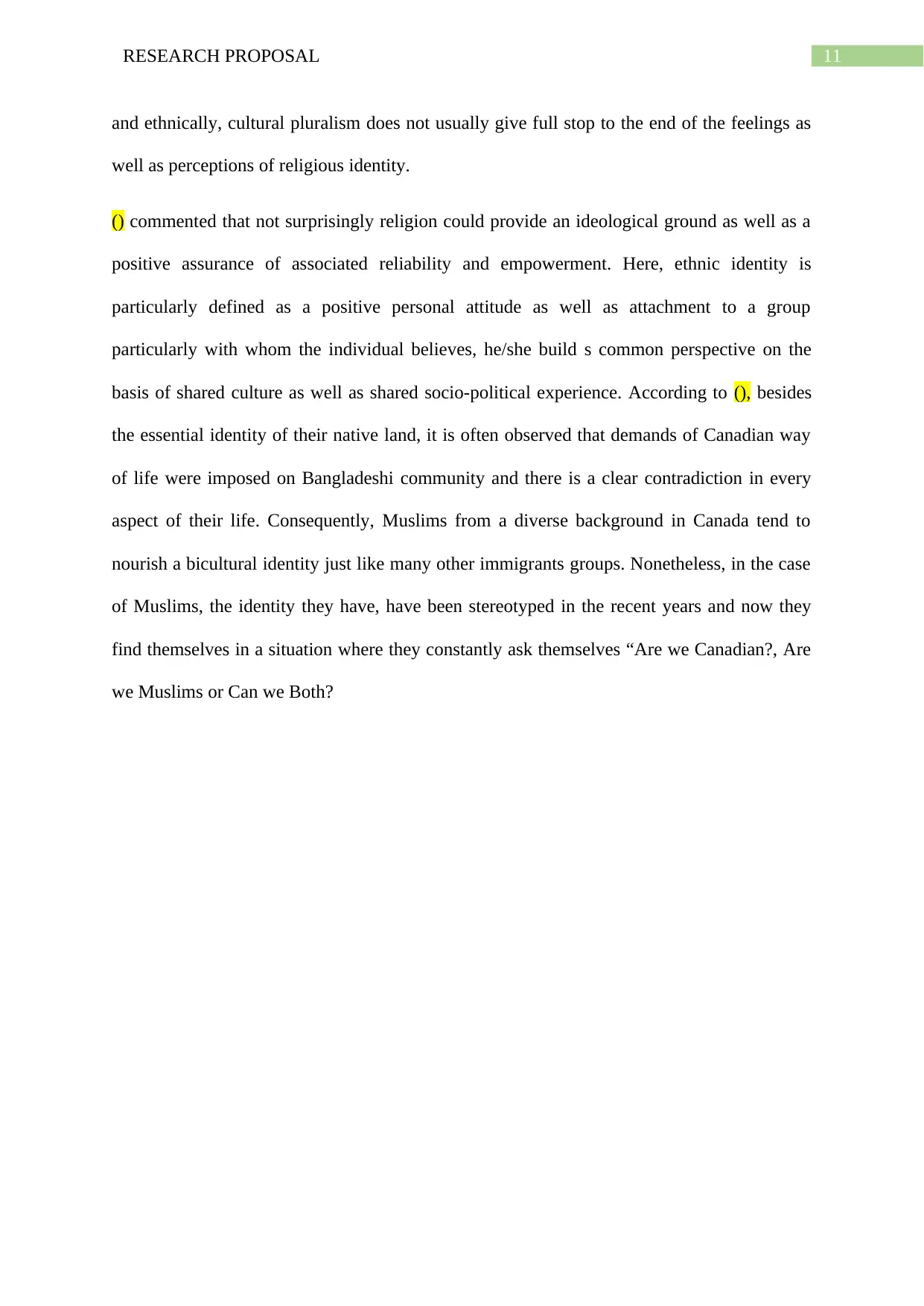
11RESEARCH PROPOSAL
and ethnically, cultural pluralism does not usually give full stop to the end of the feelings as
well as perceptions of religious identity.
() commented that not surprisingly religion could provide an ideological ground as well as a
positive assurance of associated reliability and empowerment. Here, ethnic identity is
particularly defined as a positive personal attitude as well as attachment to a group
particularly with whom the individual believes, he/she build s common perspective on the
basis of shared culture as well as shared socio-political experience. According to (), besides
the essential identity of their native land, it is often observed that demands of Canadian way
of life were imposed on Bangladeshi community and there is a clear contradiction in every
aspect of their life. Consequently, Muslims from a diverse background in Canada tend to
nourish a bicultural identity just like many other immigrants groups. Nonetheless, in the case
of Muslims, the identity they have, have been stereotyped in the recent years and now they
find themselves in a situation where they constantly ask themselves “Are we Canadian?, Are
we Muslims or Can we Both?
and ethnically, cultural pluralism does not usually give full stop to the end of the feelings as
well as perceptions of religious identity.
() commented that not surprisingly religion could provide an ideological ground as well as a
positive assurance of associated reliability and empowerment. Here, ethnic identity is
particularly defined as a positive personal attitude as well as attachment to a group
particularly with whom the individual believes, he/she build s common perspective on the
basis of shared culture as well as shared socio-political experience. According to (), besides
the essential identity of their native land, it is often observed that demands of Canadian way
of life were imposed on Bangladeshi community and there is a clear contradiction in every
aspect of their life. Consequently, Muslims from a diverse background in Canada tend to
nourish a bicultural identity just like many other immigrants groups. Nonetheless, in the case
of Muslims, the identity they have, have been stereotyped in the recent years and now they
find themselves in a situation where they constantly ask themselves “Are we Canadian?, Are
we Muslims or Can we Both?
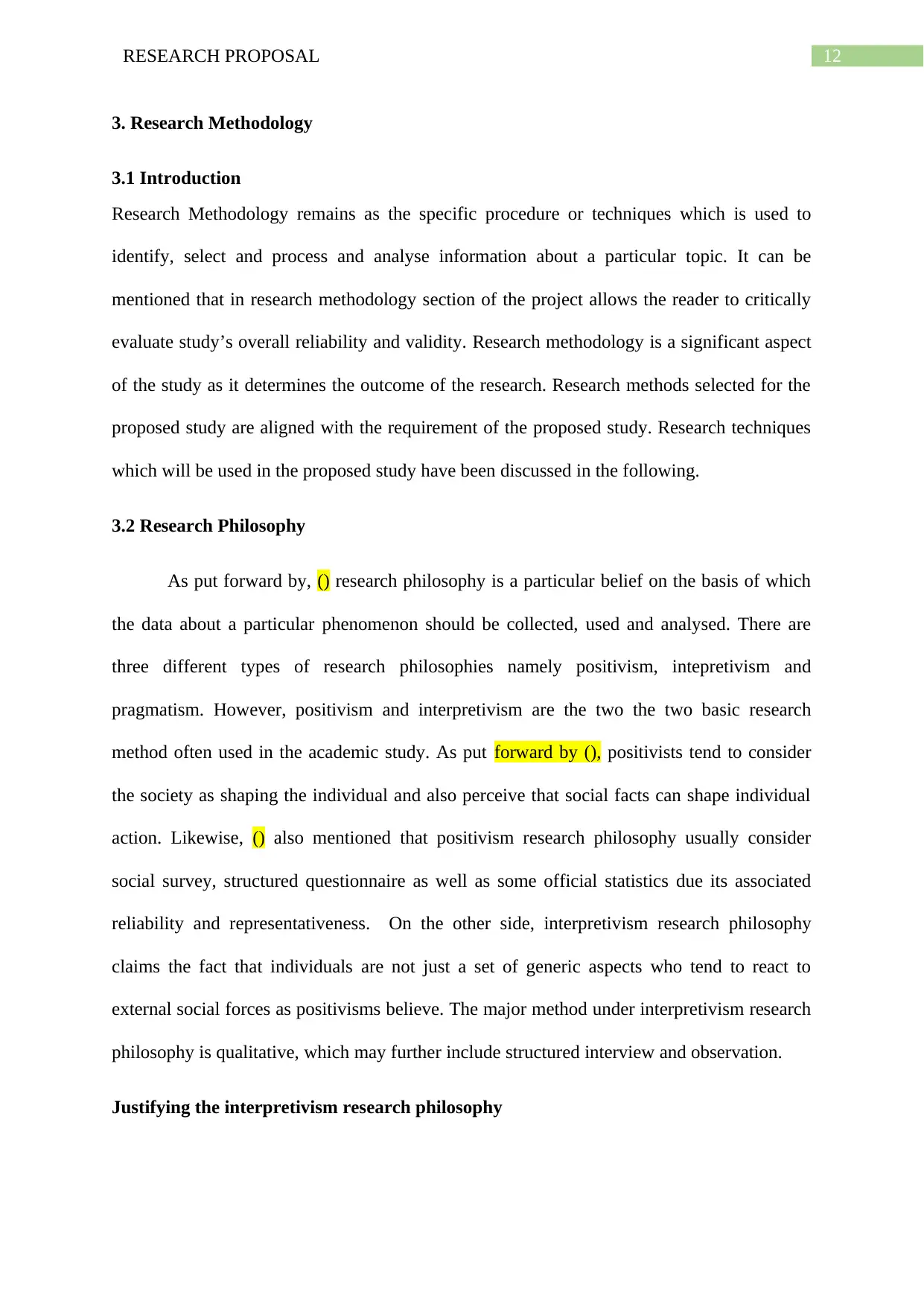
12RESEARCH PROPOSAL
3. Research Methodology
3.1 Introduction
Research Methodology remains as the specific procedure or techniques which is used to
identify, select and process and analyse information about a particular topic. It can be
mentioned that in research methodology section of the project allows the reader to critically
evaluate study’s overall reliability and validity. Research methodology is a significant aspect
of the study as it determines the outcome of the research. Research methods selected for the
proposed study are aligned with the requirement of the proposed study. Research techniques
which will be used in the proposed study have been discussed in the following.
3.2 Research Philosophy
As put forward by, () research philosophy is a particular belief on the basis of which
the data about a particular phenomenon should be collected, used and analysed. There are
three different types of research philosophies namely positivism, intepretivism and
pragmatism. However, positivism and interpretivism are the two the two basic research
method often used in the academic study. As put forward by (), positivists tend to consider
the society as shaping the individual and also perceive that social facts can shape individual
action. Likewise, () also mentioned that positivism research philosophy usually consider
social survey, structured questionnaire as well as some official statistics due its associated
reliability and representativeness. On the other side, interpretivism research philosophy
claims the fact that individuals are not just a set of generic aspects who tend to react to
external social forces as positivisms believe. The major method under interpretivism research
philosophy is qualitative, which may further include structured interview and observation.
Justifying the interpretivism research philosophy
3. Research Methodology
3.1 Introduction
Research Methodology remains as the specific procedure or techniques which is used to
identify, select and process and analyse information about a particular topic. It can be
mentioned that in research methodology section of the project allows the reader to critically
evaluate study’s overall reliability and validity. Research methodology is a significant aspect
of the study as it determines the outcome of the research. Research methods selected for the
proposed study are aligned with the requirement of the proposed study. Research techniques
which will be used in the proposed study have been discussed in the following.
3.2 Research Philosophy
As put forward by, () research philosophy is a particular belief on the basis of which
the data about a particular phenomenon should be collected, used and analysed. There are
three different types of research philosophies namely positivism, intepretivism and
pragmatism. However, positivism and interpretivism are the two the two basic research
method often used in the academic study. As put forward by (), positivists tend to consider
the society as shaping the individual and also perceive that social facts can shape individual
action. Likewise, () also mentioned that positivism research philosophy usually consider
social survey, structured questionnaire as well as some official statistics due its associated
reliability and representativeness. On the other side, interpretivism research philosophy
claims the fact that individuals are not just a set of generic aspects who tend to react to
external social forces as positivisms believe. The major method under interpretivism research
philosophy is qualitative, which may further include structured interview and observation.
Justifying the interpretivism research philosophy
Paraphrase This Document
Need a fresh take? Get an instant paraphrase of this document with our AI Paraphraser
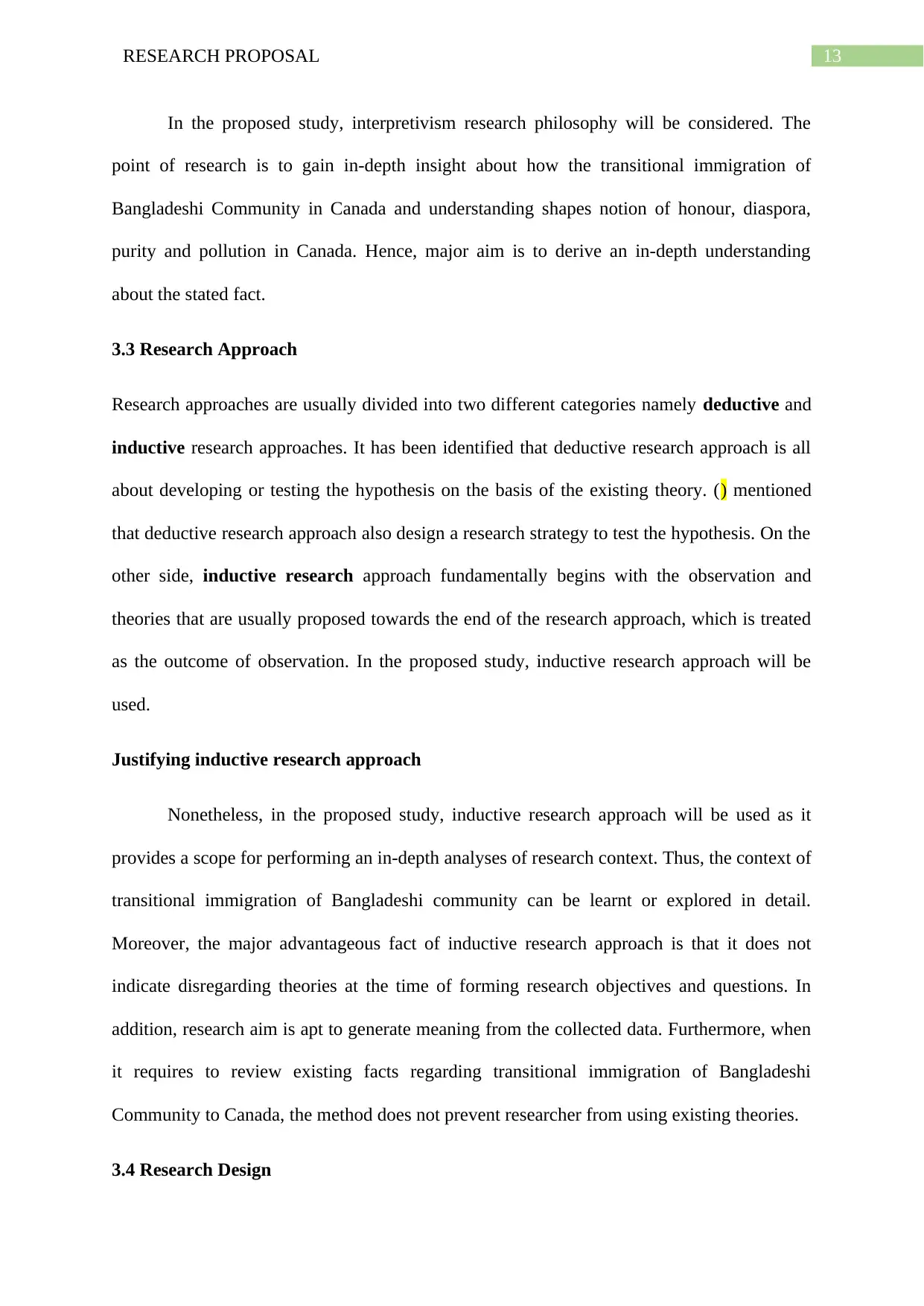
13RESEARCH PROPOSAL
In the proposed study, interpretivism research philosophy will be considered. The
point of research is to gain in-depth insight about how the transitional immigration of
Bangladeshi Community in Canada and understanding shapes notion of honour, diaspora,
purity and pollution in Canada. Hence, major aim is to derive an in-depth understanding
about the stated fact.
3.3 Research Approach
Research approaches are usually divided into two different categories namely deductive and
inductive research approaches. It has been identified that deductive research approach is all
about developing or testing the hypothesis on the basis of the existing theory. () mentioned
that deductive research approach also design a research strategy to test the hypothesis. On the
other side, inductive research approach fundamentally begins with the observation and
theories that are usually proposed towards the end of the research approach, which is treated
as the outcome of observation. In the proposed study, inductive research approach will be
used.
Justifying inductive research approach
Nonetheless, in the proposed study, inductive research approach will be used as it
provides a scope for performing an in-depth analyses of research context. Thus, the context of
transitional immigration of Bangladeshi community can be learnt or explored in detail.
Moreover, the major advantageous fact of inductive research approach is that it does not
indicate disregarding theories at the time of forming research objectives and questions. In
addition, research aim is apt to generate meaning from the collected data. Furthermore, when
it requires to review existing facts regarding transitional immigration of Bangladeshi
Community to Canada, the method does not prevent researcher from using existing theories.
3.4 Research Design
In the proposed study, interpretivism research philosophy will be considered. The
point of research is to gain in-depth insight about how the transitional immigration of
Bangladeshi Community in Canada and understanding shapes notion of honour, diaspora,
purity and pollution in Canada. Hence, major aim is to derive an in-depth understanding
about the stated fact.
3.3 Research Approach
Research approaches are usually divided into two different categories namely deductive and
inductive research approaches. It has been identified that deductive research approach is all
about developing or testing the hypothesis on the basis of the existing theory. () mentioned
that deductive research approach also design a research strategy to test the hypothesis. On the
other side, inductive research approach fundamentally begins with the observation and
theories that are usually proposed towards the end of the research approach, which is treated
as the outcome of observation. In the proposed study, inductive research approach will be
used.
Justifying inductive research approach
Nonetheless, in the proposed study, inductive research approach will be used as it
provides a scope for performing an in-depth analyses of research context. Thus, the context of
transitional immigration of Bangladeshi community can be learnt or explored in detail.
Moreover, the major advantageous fact of inductive research approach is that it does not
indicate disregarding theories at the time of forming research objectives and questions. In
addition, research aim is apt to generate meaning from the collected data. Furthermore, when
it requires to review existing facts regarding transitional immigration of Bangladeshi
Community to Canada, the method does not prevent researcher from using existing theories.
3.4 Research Design
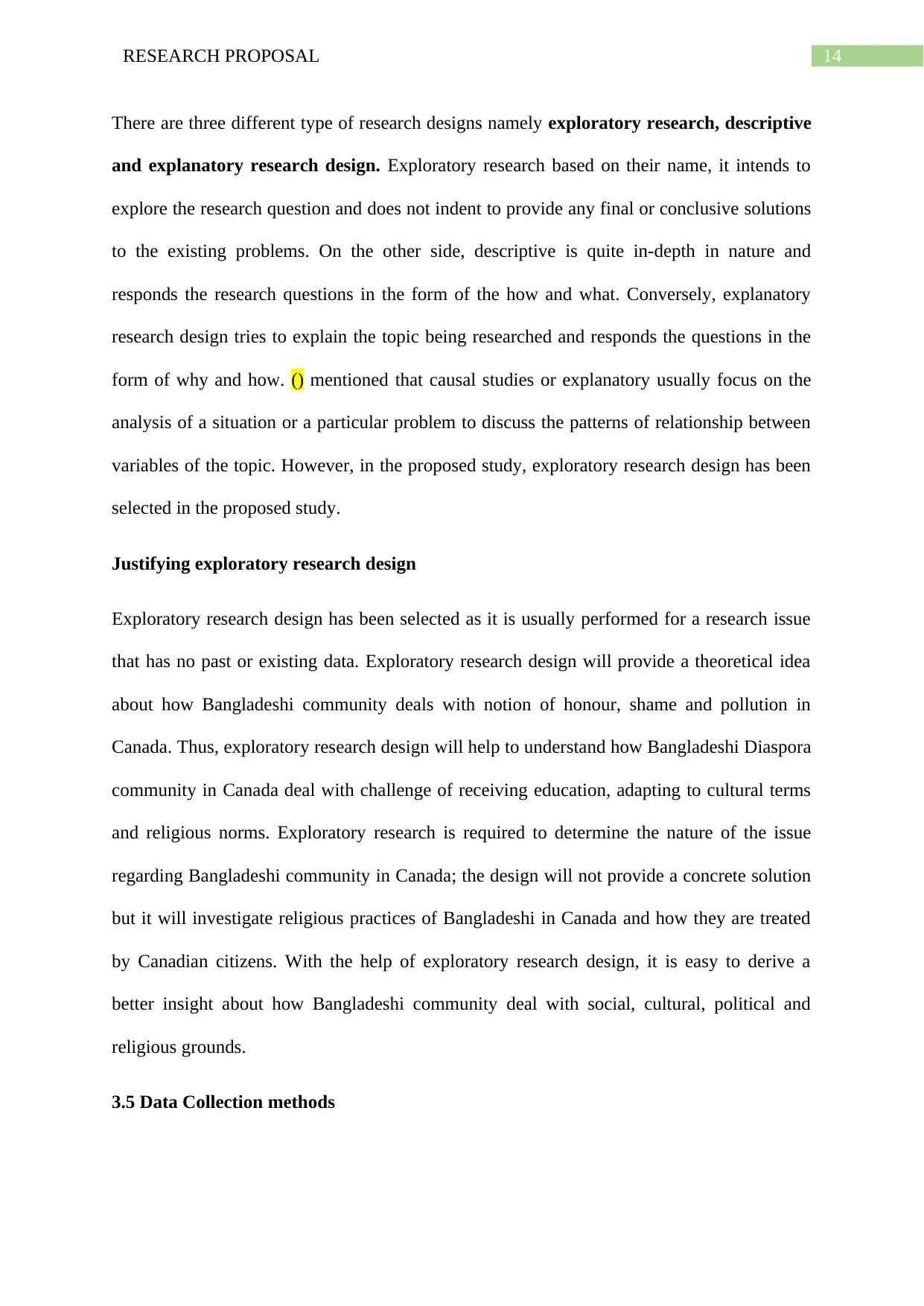
14RESEARCH PROPOSAL
There are three different type of research designs namely exploratory research, descriptive
and explanatory research design. Exploratory research based on their name, it intends to
explore the research question and does not indent to provide any final or conclusive solutions
to the existing problems. On the other side, descriptive is quite in-depth in nature and
responds the research questions in the form of the how and what. Conversely, explanatory
research design tries to explain the topic being researched and responds the questions in the
form of why and how. () mentioned that causal studies or explanatory usually focus on the
analysis of a situation or a particular problem to discuss the patterns of relationship between
variables of the topic. However, in the proposed study, exploratory research design has been
selected in the proposed study.
Justifying exploratory research design
Exploratory research design has been selected as it is usually performed for a research issue
that has no past or existing data. Exploratory research design will provide a theoretical idea
about how Bangladeshi community deals with notion of honour, shame and pollution in
Canada. Thus, exploratory research design will help to understand how Bangladeshi Diaspora
community in Canada deal with challenge of receiving education, adapting to cultural terms
and religious norms. Exploratory research is required to determine the nature of the issue
regarding Bangladeshi community in Canada; the design will not provide a concrete solution
but it will investigate religious practices of Bangladeshi in Canada and how they are treated
by Canadian citizens. With the help of exploratory research design, it is easy to derive a
better insight about how Bangladeshi community deal with social, cultural, political and
religious grounds.
3.5 Data Collection methods
There are three different type of research designs namely exploratory research, descriptive
and explanatory research design. Exploratory research based on their name, it intends to
explore the research question and does not indent to provide any final or conclusive solutions
to the existing problems. On the other side, descriptive is quite in-depth in nature and
responds the research questions in the form of the how and what. Conversely, explanatory
research design tries to explain the topic being researched and responds the questions in the
form of why and how. () mentioned that causal studies or explanatory usually focus on the
analysis of a situation or a particular problem to discuss the patterns of relationship between
variables of the topic. However, in the proposed study, exploratory research design has been
selected in the proposed study.
Justifying exploratory research design
Exploratory research design has been selected as it is usually performed for a research issue
that has no past or existing data. Exploratory research design will provide a theoretical idea
about how Bangladeshi community deals with notion of honour, shame and pollution in
Canada. Thus, exploratory research design will help to understand how Bangladeshi Diaspora
community in Canada deal with challenge of receiving education, adapting to cultural terms
and religious norms. Exploratory research is required to determine the nature of the issue
regarding Bangladeshi community in Canada; the design will not provide a concrete solution
but it will investigate religious practices of Bangladeshi in Canada and how they are treated
by Canadian citizens. With the help of exploratory research design, it is easy to derive a
better insight about how Bangladeshi community deal with social, cultural, political and
religious grounds.
3.5 Data Collection methods
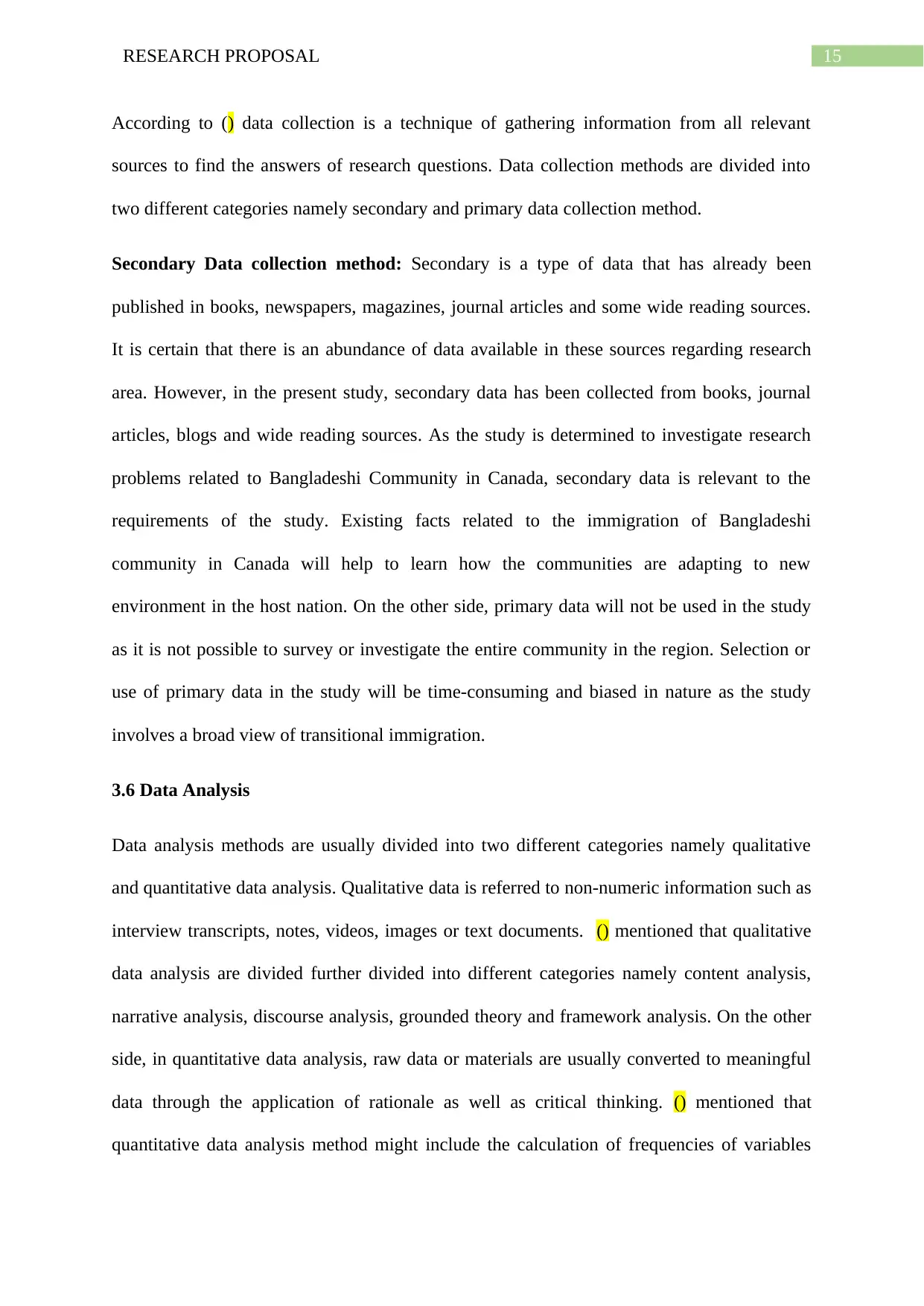
15RESEARCH PROPOSAL
According to () data collection is a technique of gathering information from all relevant
sources to find the answers of research questions. Data collection methods are divided into
two different categories namely secondary and primary data collection method.
Secondary Data collection method: Secondary is a type of data that has already been
published in books, newspapers, magazines, journal articles and some wide reading sources.
It is certain that there is an abundance of data available in these sources regarding research
area. However, in the present study, secondary data has been collected from books, journal
articles, blogs and wide reading sources. As the study is determined to investigate research
problems related to Bangladeshi Community in Canada, secondary data is relevant to the
requirements of the study. Existing facts related to the immigration of Bangladeshi
community in Canada will help to learn how the communities are adapting to new
environment in the host nation. On the other side, primary data will not be used in the study
as it is not possible to survey or investigate the entire community in the region. Selection or
use of primary data in the study will be time-consuming and biased in nature as the study
involves a broad view of transitional immigration.
3.6 Data Analysis
Data analysis methods are usually divided into two different categories namely qualitative
and quantitative data analysis. Qualitative data is referred to non-numeric information such as
interview transcripts, notes, videos, images or text documents. () mentioned that qualitative
data analysis are divided further divided into different categories namely content analysis,
narrative analysis, discourse analysis, grounded theory and framework analysis. On the other
side, in quantitative data analysis, raw data or materials are usually converted to meaningful
data through the application of rationale as well as critical thinking. () mentioned that
quantitative data analysis method might include the calculation of frequencies of variables
According to () data collection is a technique of gathering information from all relevant
sources to find the answers of research questions. Data collection methods are divided into
two different categories namely secondary and primary data collection method.
Secondary Data collection method: Secondary is a type of data that has already been
published in books, newspapers, magazines, journal articles and some wide reading sources.
It is certain that there is an abundance of data available in these sources regarding research
area. However, in the present study, secondary data has been collected from books, journal
articles, blogs and wide reading sources. As the study is determined to investigate research
problems related to Bangladeshi Community in Canada, secondary data is relevant to the
requirements of the study. Existing facts related to the immigration of Bangladeshi
community in Canada will help to learn how the communities are adapting to new
environment in the host nation. On the other side, primary data will not be used in the study
as it is not possible to survey or investigate the entire community in the region. Selection or
use of primary data in the study will be time-consuming and biased in nature as the study
involves a broad view of transitional immigration.
3.6 Data Analysis
Data analysis methods are usually divided into two different categories namely qualitative
and quantitative data analysis. Qualitative data is referred to non-numeric information such as
interview transcripts, notes, videos, images or text documents. () mentioned that qualitative
data analysis are divided further divided into different categories namely content analysis,
narrative analysis, discourse analysis, grounded theory and framework analysis. On the other
side, in quantitative data analysis, raw data or materials are usually converted to meaningful
data through the application of rationale as well as critical thinking. () mentioned that
quantitative data analysis method might include the calculation of frequencies of variables
Secure Best Marks with AI Grader
Need help grading? Try our AI Grader for instant feedback on your assignments.
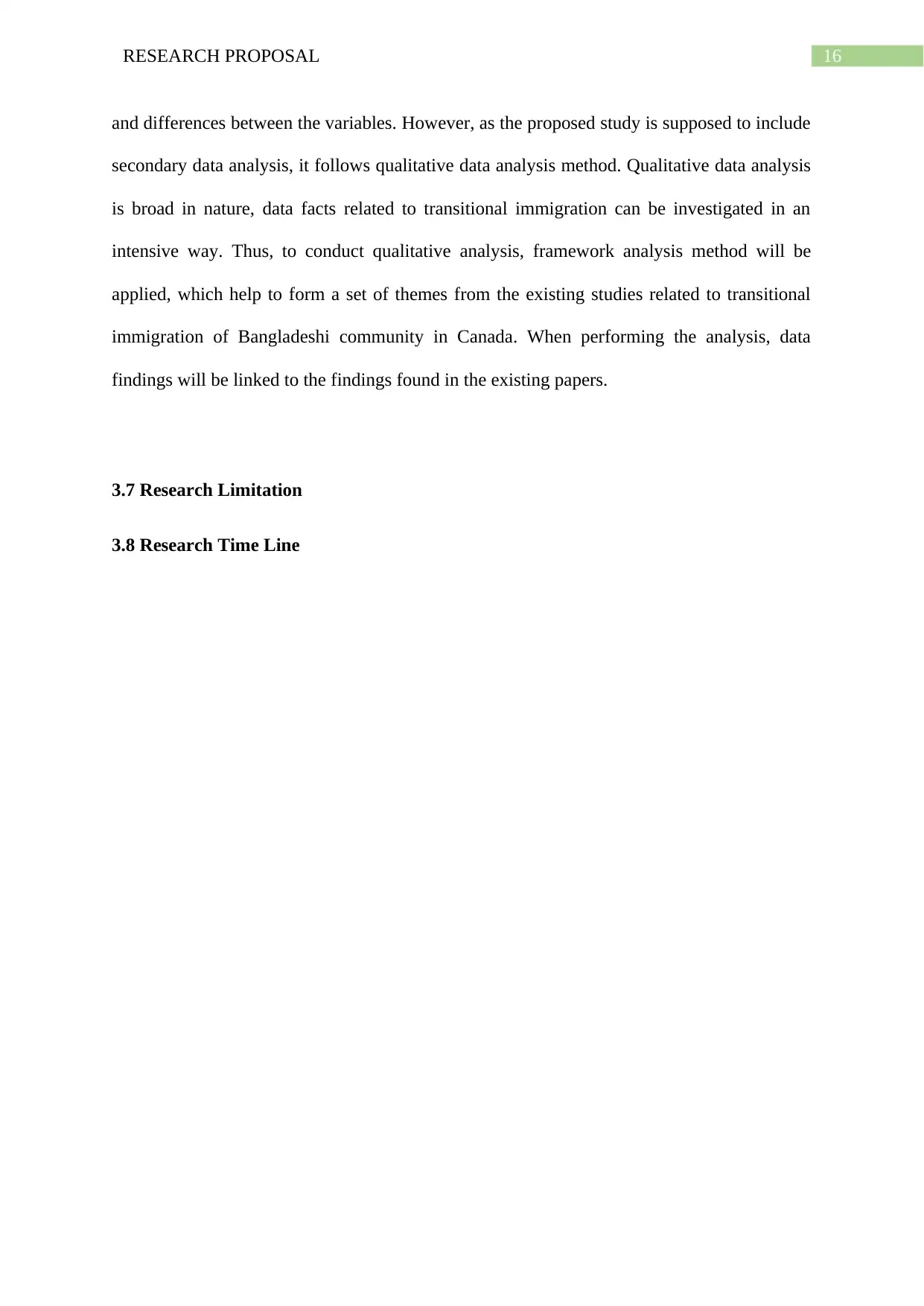
16RESEARCH PROPOSAL
and differences between the variables. However, as the proposed study is supposed to include
secondary data analysis, it follows qualitative data analysis method. Qualitative data analysis
is broad in nature, data facts related to transitional immigration can be investigated in an
intensive way. Thus, to conduct qualitative analysis, framework analysis method will be
applied, which help to form a set of themes from the existing studies related to transitional
immigration of Bangladeshi community in Canada. When performing the analysis, data
findings will be linked to the findings found in the existing papers.
3.7 Research Limitation
3.8 Research Time Line
and differences between the variables. However, as the proposed study is supposed to include
secondary data analysis, it follows qualitative data analysis method. Qualitative data analysis
is broad in nature, data facts related to transitional immigration can be investigated in an
intensive way. Thus, to conduct qualitative analysis, framework analysis method will be
applied, which help to form a set of themes from the existing studies related to transitional
immigration of Bangladeshi community in Canada. When performing the analysis, data
findings will be linked to the findings found in the existing papers.
3.7 Research Limitation
3.8 Research Time Line
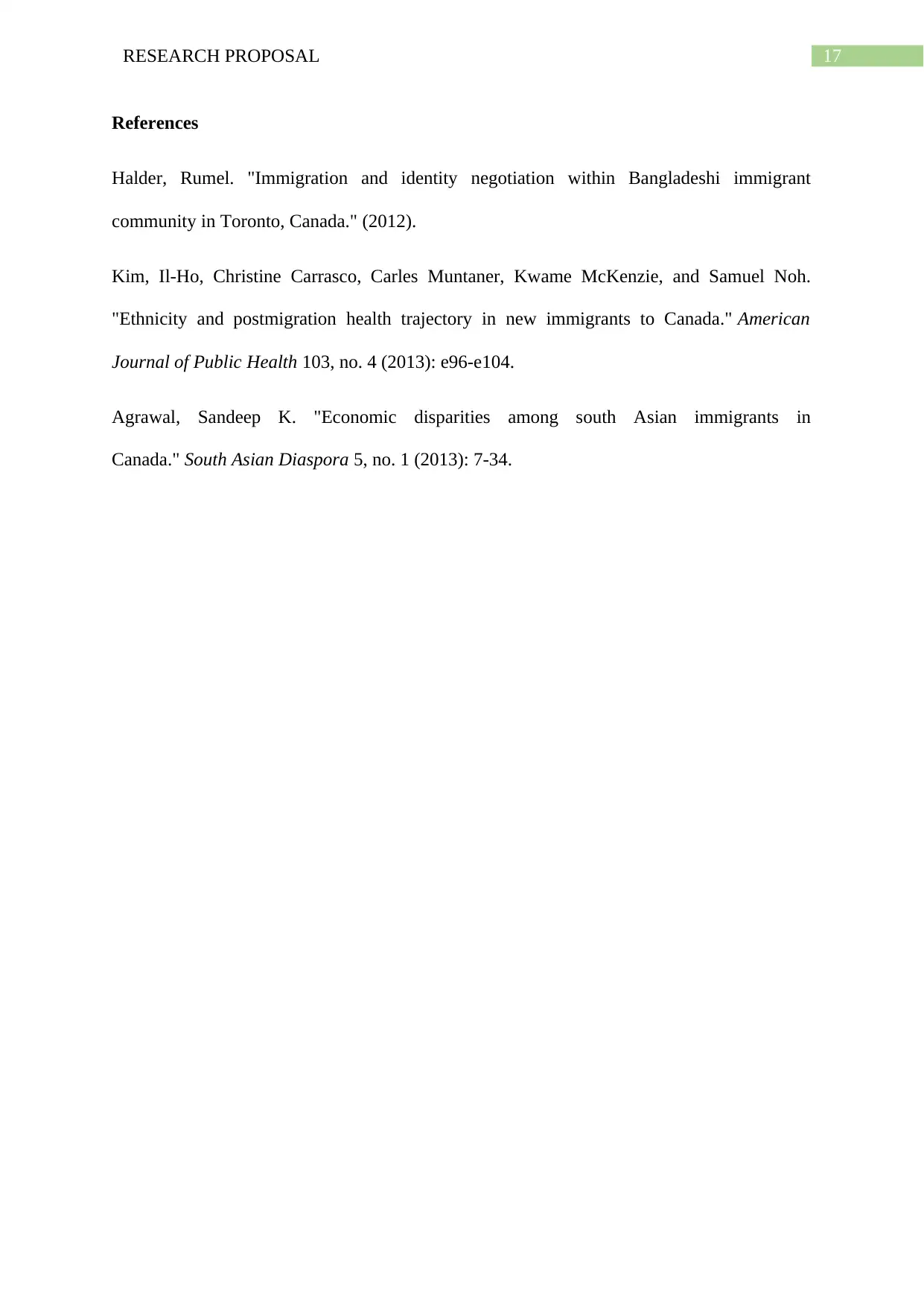
17RESEARCH PROPOSAL
References
Halder, Rumel. "Immigration and identity negotiation within Bangladeshi immigrant
community in Toronto, Canada." (2012).
Kim, Il-Ho, Christine Carrasco, Carles Muntaner, Kwame McKenzie, and Samuel Noh.
"Ethnicity and postmigration health trajectory in new immigrants to Canada." American
Journal of Public Health 103, no. 4 (2013): e96-e104.
Agrawal, Sandeep K. "Economic disparities among south Asian immigrants in
Canada." South Asian Diaspora 5, no. 1 (2013): 7-34.
References
Halder, Rumel. "Immigration and identity negotiation within Bangladeshi immigrant
community in Toronto, Canada." (2012).
Kim, Il-Ho, Christine Carrasco, Carles Muntaner, Kwame McKenzie, and Samuel Noh.
"Ethnicity and postmigration health trajectory in new immigrants to Canada." American
Journal of Public Health 103, no. 4 (2013): e96-e104.
Agrawal, Sandeep K. "Economic disparities among south Asian immigrants in
Canada." South Asian Diaspora 5, no. 1 (2013): 7-34.
1 out of 18
Your All-in-One AI-Powered Toolkit for Academic Success.
+13062052269
info@desklib.com
Available 24*7 on WhatsApp / Email
![[object Object]](/_next/static/media/star-bottom.7253800d.svg)
Unlock your academic potential
© 2024 | Zucol Services PVT LTD | All rights reserved.
